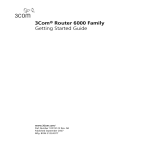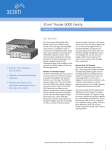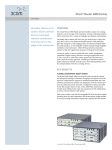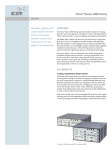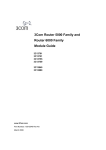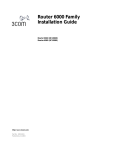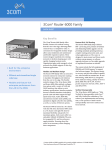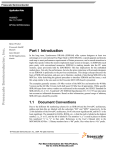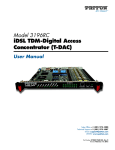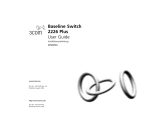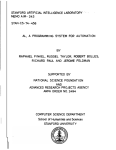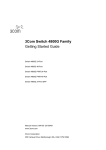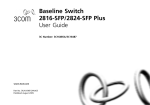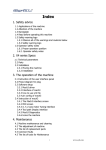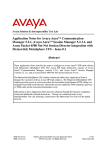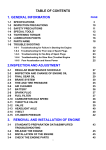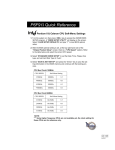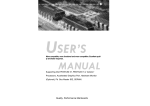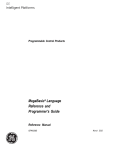Download 3Com Router 3C13840 Owner's Manual
Transcript
3Com Router 6000 Family Installation Guide 3C13840 3C13880 www.3Com.com Part Number: 10015047 Rev AB June 2006 Copyright © 2006, 3Com Corporation. All rights reserved. No part of this documentation may be reproduced in any form or by any means or used to make any derivative work (such as translation, transformation, or adaptation) without written permission from 3Com Corporation. 3Com Corporation reserves the right to revise this documentation and to make changes in content from time to time without obligation on the part of 3Com Corporation to provide notification of such revision or change. 3Com Corporation provides this documentation without warranty, term, or condition of any kind, either implied or expressed, including, but not limited to, the implied warranties, terms or conditions of merchantability, satisfactory quality, and fitness for a particular purpose. 3Com may make improvements or changes in the product(s) and/or the program(s) described in this documentation at any time. If there is any software on removable media described in this documentation, it is furnished under a license agreement included with the product as a separate document, in the hard copy documentation, or on the removable media in a directory file named LICENSE.TXT or !LICENSE.TXT. If you are unable to locate a copy, please contact 3Com and a copy will be provided to you. UNITED STATES GOVERNMENT LEGEND If you are a United States government agency, then this documentation and the software described herein are provided to you subject to the following: All technical data and computer software are commercial in nature and developed solely at private expense. Software is delivered as “Commercial Computer Software” as defined in DFARS 252.227-7014 (June 1995) or as a “commercial item” as defined in FAR 2.101(a) and as such is provided with only such rights as are provided in 3Com’s standard commercial license for the Software. Technical data is provided with limited rights only as provided in DFAR 252.227-7015 (Nov 1995) or FAR 52.227-14 (June 1987), whichever is applicable. You agree not to remove or deface any portion of any legend provided on any licensed program or documentation contained in, or delivered to you in conjunction with, this User Guide. Unless otherwise indicated, 3Com registered trademarks are registered in the United States and may or may not be registered in other countries. 3Com, the 3Com logo, are registered trademarks of 3Com Corporation. Intel and Pentium are registered trademarks of Intel Corporation. Microsoft, MS-DOS, Windows, and Windows NT are registered trademarks of Microsoft Corporation. UNIX is a registered trademark in the United States and other countries, licensed exclusively through X/Open Company, Ltd. All other company and product names may be trademarks of the respective companies with which they are associated. 3Com Corporation 350 Campus Drive Marlborough, MA 01752-3064 3Com Router 6000 Family Installation Manual Table of Contents Table of Contents Chapter 1 Router Overview .......................................................................................................... 1-2 1.1 Introduction ........................................................................................................................ 1-2 1.2 Router Model and Structure............................................................................................... 1-4 1.2.1 3Com Router 6040.................................................................................................. 1-4 1.2.2 3Com Router 6080.................................................................................................. 1-5 1.3 System Description ............................................................................................................ 1-6 1.4 Generic Modules................................................................................................................ 1-7 1.4.1 RPU2....................................................................................................................... 1-7 1.4.2 PSU ......................................................................................................................... 1-9 1.4.3 FAN module .......................................................................................................... 1-10 1.4.4 FICs....................................................................................................................... 1-11 Chapter 2 Preparing for Installation ............................................................................................ 2-1 2.1 General Site Requirements ............................................................................................... 2-1 2.1.1 Temperature and Humidity...................................................................................... 2-1 2.1.2 Cleanness ............................................................................................................... 2-1 2.1.3 ESD Prevention....................................................................................................... 2-2 2.1.4 Electromagnetic Compatibility................................................................................. 2-2 2.1.5 Lightning Protection ................................................................................................ 2-3 2.1.6 Checking the Rack .................................................................................................. 2-3 2.2 Safety Precautions............................................................................................................. 2-3 2.3 Unpacking Check............................................................................................................... 2-4 2.4 Installation Tools and Meters and Equipment ................................................................... 2-5 Chapter 3 Installing The Router ................................................................................................... 3-1 3.1 Installation Flow ................................................................................................................. 3-1 3.2 Installing the Cabinet/Rack ................................................................................................ 3-2 3.3 Mounting the Router .......................................................................................................... 3-2 3.3.1 Rack-Mounting the Router ...................................................................................... 3-2 3.3.2 Mounting the Router on a Tabletop......................................................................... 3-3 3.4 Installing the Generic Modules .......................................................................................... 3-3 3.5 Connecting the PGND ....................................................................................................... 3-3 3.6 Connecting the Power Cord............................................................................................... 3-4 3.6.1 Connecting the AC-Input Power Cord..................................................................... 3-4 3.6.2 Connecting the DC-Input Power Cord .................................................................... 3-5 3.7 Connecting the Console Terminal ..................................................................................... 3-6 3.8 Connecting the Router to a LAN........................................................................................ 3-7 3.9 Connecting the Router to a WAN ...................................................................................... 3-9 3.10 Verifying Installation....................................................................................................... 3-10 3Com Corporation i 3Com Router 6000 Family Installation Manual Table of Contents Chapter 4 Starting and Configuring the Router ....................................................................... 4-11 4.1 Starting the Router........................................................................................................... 4-11 4.1.1 Setting up a Configuration Environment ............................................................... 4-11 4.1.2 Powering on the Router ........................................................................................ 4-15 4.1.3 Boot Process of the RPU2 .................................................................................... 4-15 4.2 Router Configuration Basics ............................................................................................ 4-17 4.2.1 Basic Configuration Procedures............................................................................ 4-17 4.2.2 Command Line Interface....................................................................................... 4-17 4.2.3 Arranging Slots and Numbering Interfaces ........................................................... 4-18 Chapter 5 Maintaining Software................................................................................................... 5-1 5.1 Overview ............................................................................................................................ 5-1 5.2 Maintaining Software of the RPU2..................................................................................... 5-1 5.2.1 Boot Menu ............................................................................................................... 5-1 5.2.2 Upgrading Software Using Xmodem....................................................................... 5-4 5.2.3 Backing Up/Restoring the Extended Segment of the Boot ROM Image................. 5-8 5.2.4 Upgrading the Application Image Using TFTP........................................................ 5-9 5.3 Dealing with a Router Password Loss............................................................................. 5-10 Chapter 6 Maintaining Hardware ................................................................................................. 6-1 6.1 Preparing Tools.................................................................................................................. 6-1 6.2 Removing/Installing PSUs ................................................................................................. 6-1 6.2.1 Removing a PSU..................................................................................................... 6-1 6.2.2 Installing a PSU....................................................................................................... 6-2 6.3 Removing/Installing the Fan Module ................................................................................. 6-2 6.3.1 Removing the Fan Module ...................................................................................... 6-2 6.3.2 Installing the Fan Module ........................................................................................ 6-3 6.4 Removing/Installing the Main Control Board ..................................................................... 6-3 6.4.1 Removing the RPU2 ............................................................................................... 6-3 6.4.2 Installing the RPU2 ................................................................................................. 6-4 6.5 Replacing the SDRAM....................................................................................................... 6-4 6.6 Removing/Installing the Encryption Daughter Card........................................................... 6-6 6.6.1 Removing the Encryption Daughter Card ............................................................... 6-6 6.6.2 Installing the Encryption Daughter Card ................................................................. 6-7 Chapter 7 Troubleshooting .......................................................................................................... 7-1 7.1 Troubleshooting the Power System................................................................................... 7-1 7.2 Troubleshooting the Configuration System ....................................................................... 7-1 7.3 Troubleshooting Application Image Upgrade .................................................................... 7-2 Chapter 8 Installing B68 Cabinets ............................................................................................... 8-1 8.1 Installation Requirements and Procedures........................................................................ 8-1 8.1.1 Planning the Site ..................................................................................................... 8-1 8.1.2 General Installation Procedures.............................................................................. 8-2 8.2 Mounting Cabinets on the Concrete Floor......................................................................... 8-3 3Com Corporation ii 3Com Router 6000 Family Installation Manual Table of Contents 8.2.1 Components of Integrated Anchor Strips................................................................ 8-3 8.2.2 Installation Flow....................................................................................................... 8-4 8.2.3 Positioning Cabinets ............................................................................................... 8-5 8.2.4 Adjusting Cabinet Feet............................................................................................ 8-8 8.2.5 Combining Cabinets................................................................................................ 8-9 8.2.6 Fixing Cabinets...................................................................................................... 8-11 8.2.7 Testing Insulation .................................................................................................. 8-12 8.3 Mounting Cabinets on the Antistatic Floor....................................................................... 8-14 8.3.1 Introduction to Racks ............................................................................................ 8-14 8.3.2 Introduction to Slide Rails ..................................................................................... 8-17 8.3.3 Installation Flow..................................................................................................... 8-17 8.3.4 Positioning Racks.................................................................................................. 8-18 8.3.5 Installing Racks ..................................................................................................... 8-22 8.3.6 Installing Slide Rails .............................................................................................. 8-23 8.3.7 Installing Antistatic Floor Supports........................................................................ 8-25 8.3.8 Leveling Cabinets.................................................................................................. 8-27 8.3.9 Combining Cabinets.............................................................................................. 8-29 8.3.10 Fixing Cabinets.................................................................................................... 8-31 8.3.11 Testing Insulation ................................................................................................ 8-32 8.3.12 Restoring the Floor.............................................................................................. 8-33 3Com Corporation iii 3Com Router 6000 Family Installation Manual Chapter 1 Preparing for Installation Chapter 1 Router Overview 1.1 Introduction 3Com 6000 Routers are next generation high-performance edge routers that 3Com Corporation solely developed. They provide high forwarding performance and a broad service range. The Router 6000 supports flexible interface cards (FICs), hot swappable fan modules and power supply units (PSUs) in 1+1 redundancy. Along with the NE Series Routers, the Router 6000 provides complete network solutions for service providers and enterprises. The following are the major features of the Router 6000. I. Abundant FIC options Abundant FICs are available with the Router 6000 allowing great flexibility and investment protection. II. Ethernet access The electrical and fiber (multi-mode and single-mode) FE FICs available with the Router 6000 support PPPoE and PPPoEoA that can offer authentication, authorization, and accounting (AAA) services for Ethernet access, hence satisfying the requirements of government offices and enterprises in broadband access. III. ATM and DSL Digital subscriber line (DSL) is a simple but highly efficient broadband technology that achieves great data transmission capacity over existing copper wiring by using the digital code modulation technology. Installed with an ADSL or G.HSDSL card, the Router 6000 can connect the medium-to-small-sized enterprises to the digital subscriber line access multiplexer (DSLAM) equipment through a public switched telephone network (PSTN) and then to the Internet. Asynchronous transfer mode (ATM) transmits, multiplexes, and switches information in cells. The Router 6000 can be installed with these ATM cards: 25 Mbps, 155 Mbps, E3, and T3. The cards support ATM adaption layer type 5 (AAL5) and offer traffic services such as constant bit rate (CBR), variable bit rate (VBR) and unspecified bit rate (UBR). They are well-suited to transfer large packets and provide high-speed data services. A medium-and-small-sized enterprise can use them to connect its network to an ATM network. IV. MPLS Multiprotocol label switching (MPLS), a combination of IP and ATM technologies, replaces the IP header with a short and length-fixed label as traffic identifier, based on each routers 3Com Corporation 1-2 3Com Router 6000 Family Installation Manual Chapter 1 Preparing for Installation forwarding decision. It thus provides faster forwarding speed, gets support from IP routed protocols and control protocols, and accommodates to emerging applications. MPLS VPN is a VPN technology that uses label switched paths (LSPs) to interconnect private networks. As a LSP is virtually a tunnel across the public network, MPLS has an intrinsic advantage in terms of VPN implementation. The 3Com 6000 Routers usually act as label edge routers (LERs) to connect an MPLS domain with a non-MPLS domain or connect MPLS domains of different service providers, implementing service classification, label distribution, encapsulation, and multi-label peel-off. V. Data security and reliability The following are the data security and reliability features that the Router 6000 supports: z NAT. Besides some basic functions, NAT can limit concurrent connections to a single user, and thus alleviate negative impacts caused by malicious resource occupation without affecting the normal network applications. In addition, NAT of the Router 6000 also provides the application layer gateway (ALG) function specific to FTP and ICMP. z Authentication protocols such as PAP, CHAP, data RADIUS, and VoIP RADIUS. z Packet filter and firewall, which fend off external attacks. z VPN (including GRE, L2TP, and MPLS) and the technologies of IPSec and IKE. They can ensure security of private networks in an Internet environment. z Backup center and virtual router redundancy protocol (VRRP). By providing a backup scheme in case of communication line or device failures, they enhance robustness and reliability of networks. Backup center also supports backup load sharing. z Hot swappable fans, interface cards, and PSUs to ensure high reliability. VI. Online software upgrading You are allowed to upgrade application and Boot ROM programs, and add new features and functions on line as needed. VII. Abundant fault isolation methods z The monitoring of the states of system configurations, system service channels, and system resources is available, as well as fault indication via console and network management host. In addition, logging function is provided for recording and outputting the abnormal information. z You are allowed to monitor the FIC running state and make the judgment by observing the LEDs on FIC panels. z You are also provided with the functions of in-service system test and out-of-service system test. In addition, loopback test and hardware key module self-test are allowed. 3Com Corporation 1-3 3Com Router 6000 Family Installation Manual Chapter 1 Preparing for Installation VIII. Regulatory compliance The 3Com 6000 Routers are designed in compliance with the regulations and standards of China, North America, Europe, Europe, Australia, and Japan in EMC, safety, network access, and some other aspects. 1.2 Router Model and Structure The Router 6000 includes 3Com Router 6040 and 3Com Router 6080. These two models are similar in chassis structure and layout. Both use a mid-backplane allowing front and rear card insertion and can be mounted in 19-inch standard racks. The following subsections will give you more details about these two models. 1.2.1 3Com Router 6040 (1) (2) (3) (5) (6) 1) Slot0 for the main control board 4) FIC Slot3 2) FIC Slot1 5) FIC Slot4 (4) 3) FIC Slot2 6) ESD-preventive wrist strap port Figure 1-1 Front panel of the 3Com Router 6040 (1) (3) (2) (4) 1) Fan module 4) PSU 1 (PWR1) (5) 2) Grounding screw 5) PSU 2 (PWR2) 3) ESD-preventive wrist strap port Figure 1-2 Rear panel of the 3Com Router 6040 The 3Com Router 6040 has five slots on the front panel, with slot 0 for the main control unit and slots 1 through 4 for FICs. At the bottom right of the front panel is an ESD-preventive wrist strap port. 3Com Corporation 1-4 3Com Router 6000 Family Installation Manual Chapter 1 Preparing for Installation Two PSUs (DC or AC), working in 1+1 backup mode, can be horizontally installed in the 3Com Router 6040 from the rear of the chassis. The fan module is located at the left rear. Both PSUs and the fan module are hot swappable. At the bottom left of the rear panel is an ESD-preventive wrist strap port and at the top right is a grounding screw. 1.2.2 3Com Router 6080 (1) (1) (2) (4) (6) (3) (5) (7) (8) (9) (10) (11) 1) Holes for holding the chassis 4) FIC Slot2 7) FIC Slot5 10) FIC Slot8 2) Slot0 for the main control board 5) FIC Slot3 8) FIC Slot6 11) ESD-preventive wrist strap port 3) FIC Slot1 6) FIC Slot4 9) FIC Slot7 Figure 1-3 Front panel of the 3Com Router 6080 (1) (3) (2) (4) 1) Fan module 4) PSU 1 (PWR1) (5) 2) Grounding screw 5) PSU 2 (PWR2) 3) ESD-preventive wrist strap port Figure 1-4 Rear panel of the 3Com Router 6080 The 3Com Router 6080 has nine slots on the front panel, with slot 0 for the main control unit and slots 1 through 8 for FICs. At the bottom right of the front panel is an ESD-preventive wrist strap port. Two PSUs (AC-input or DC-input), working in 1+1 backup mode, can be horizontally installed in the 3Com Router 6080 from the rear of the chassis. The fan module is located at the left rear. 3Com Corporation 1-5 3Com Router 6000 Family Installation Manual Chapter 1 Preparing for Installation Both PSUs and the fan module are hot swappable. At the bottom left of the rear panel is an ESD-preventive wrist strap port and at the top right is a grounding screw. 1.3 System Description Table 1-1 System description of the 3Com Router 6040/ 6080 3COM ROUTER 6040 Item 3COM ROUTER 6080 FIC slot 4 8 Dimensions (H x W x D) 130.5 x 436.2 x 420 mm (5.1 x 17.2 x 16.5 in.) 219.5 x 436.2 x 420 mm (8.6 x 17.2 x 16.5 in.) Weight 18.7 kg (41.2 lb.) 28 kg (61.7 lb.) AC + AC Input voltage DC + DC Rated voltage: 100 to 240 VAC; 50/60 Hz Max. voltage: 85 to 264 VAC; 50/60 Hz Max. current: 4.0A/2.0A/2.0A (3Com Router 6080/6040) Rated voltage: -48 to -60 VDC. Max. voltage: -36 to -75 VDC. Max. current: 9.0 A/5.0 A/4.0 A (3Com Router 6080/6040) Max. power 126 W Operating temperature 0 to 40 C (32°F to 104°F) Relative humidity (non-condensing) 5 to 90% 213 W o Note: The selection of SDRAM and Flash memory depends on the main control board. For their specifications, refer to the sections “RPU”. The standard shipment provides a single PSU for power supply, but you can order one more PSU for redundancy. 3Com Corporation 1-6 3Com Router 6000 Family Installation Manual Chapter 1 Preparing for Installation 1.4 Generic Modules The generic modules of the Router 6000 include the main control board –RPU2, or RPU2(H), PSU, FAN, and FICs, which are described in the following subsections. 1.4.1 RPU2 Figure 1-5 RPU2 I. Specifications Table 1-2 RPU2 specifications Item Specifications 2 x 10/100/1000 Mbps electrical Ethernet interfaces Fixed interface 1 x 10/100/1000 Mbps Ethernet interface (providing both electrical and fiber-optic connectors) 1 AUX port 1 console port CF card slot (the CF card is optional) Processor 700 MHz Boot ROM 512 KB NVRAM 512 KB DDR SDRAM 512 MB Flash 64 MB Note: SDRAM is the memory where the communication data between the system and CPU is stored. NVRAM is the place where the alarm records are stored. Flash functions as the major file storage medium to store application program files, anomaly information, and configuration files. Boot ROM stores the boot program files. 3Com Corporation 1-7 3Com Router 6000 Family Installation Manual Chapter 1 Preparing for Installation II. LED and button Figure 1-6 Front panel of RPU2 Table 1-3 RPU2 LEDs and the button LED and button RUN (green) ALM (red) Description RPU System operating LED. Blinking means CPU is in normal operation; steady ON or OFF means CPU has failed. FAN Steady ON means the FAN module is operating normally. PWR1 Steady ON means the PSU 1 is operating normally, and steady OFF means the PSU 1 is not present or has failed. PWR2 Steady ON means the PSU 2 is operating normally, and steady OFF means the PSU 2 is not present or has failed. RPU ON means CPU has received an alarm signal, such as PSU or FAN alarm (due to overtemperature, for example). FAN ON means the FAN module is not present or its rotation is blocked. PWR1 ON means the PSU 1 has failed. PWR2 ON means the PSU 2 has failed. OFF means no card is present. ECARD (green) ON means a card is present and initialized. Blinking means data is being transmitted or/and received. OFF means no CF card is present. CF (green) RESET 10/100/ 1000 Mbps interfac e LED ON means a CF card is present. Blinking means the CF card is reading/writing data. To prevent data corruption, do not remove the running CF card. The RPU2 hardware reset button. LINK (green) OFF means no link is present and ON means a link is present. ACT (yellow) OFF means no data is being transmitted or received on the interface and blinking means data is being transmitted or/and received. III. Interface The RPU2 provides a 10/100/1000 Mbps fiber-optic interface in addition to console port, AUX port, and 10/100/1000 Mbps electrical Ethernet interfaces. 3Com Corporation 1-8 3Com Router 6000 Family Installation Manual Chapter 1 Preparing for Installation IV. Encryption daughter card The RPU2 supports the encryption daughter card. 1.4.2 PSU I. Functions The power supply system of the Router 6000 can work in either single-power or dual-power mode. In dual-power mode, the two PSUs (DC-input or AC-input) function in redundancy or load sharing mode. That means, when a PSU fails or its power supply is disconnected, another PSU can still work and supply all the power required by the system. Both AC-input PSU and DC-input PSU are available with the Router 6000. The PSUs supply 350W power and provide overcurrent and overvoltage protection. You can connect a PSU to the backplane by inserting it from the rear of the router chassis. It is hot swappable and its switchover does not affect the ongoing system operation. Note: When installing your router in a communications equipment room, ensure that the AC power distribution cabinet can provide a lightning protection box or arrester against the current of 20 KA and above. II. Appearance Figure 1-7 AC-input PSU Figure 1-8 DC-input PSU 3Com Corporation 1-9 3Com Router 6000 Family Installation Manual Chapter 1 Preparing for Installation III. LED The following figure illustrates the front panel of AC-input PSU. Figure 1-9 Front panel of AC-input PSU The following figure illustrates the front panel of DC-input PSU. Figure 1-10 Front panel of DC-input PSU. Table 1-4 PSU LED description LED Description ALM (red) ON means the PSU is not present or has failed. RUN (green) Steady ON means the PSU is operating normally, and OFF means the PSU has failed. AC/DC OK (red) PSU input LED (only for the AC-input PSU). Steady ON means the normal voltage (85 to 264 V) is inputting, and OFF means the opposite. 1.4.3 FAN module I. Functions The 3Com Router 6040 is configured with six fans; the 3Com Router 6080 is configured with eight fans. These fans are working in pairs and the two fans in each pair are working in redundancy. When all these fans are working normally, the operating temperature of the system can be maintained between 0 and 55oC (32 to 131oF). As the failure of a fan does not affect the operation of other fans, the normal operating temperature of the system can maintain. The routing speed of the fans is adjusted by the fan controller on the main control board and between 50% and 100% depending on the system temperature. When the system temperature rises above the high-temperature threshold set by the fan controller, the fans are rotating at full speed (100%); when the system temperature drops below the low-temperature 3Com Corporation 1-10 3Com Router 6000 Family Installation Manual Chapter 1 Preparing for Installation threshold, the fans are rotating only at half of the speed (50%). When a fan stops rotating, the fan controller alarms. The alarm and state LEDs of the FAN are located on the front panel of RPU2. II. Appearance The following figure shows a FAN module, taking 3Com Router 6080 for example. Figure 1-11 FAN module (the 3Com Router 6080) 1.4.4 FICs 3Com 6000 Router Family modular routers provide FIC slots for this release and support the following FICs: z Router 1-Port T3 ATM FIC (3C13877) z Router 4-Port Fractional T1 FIC (3C13821) z Router 1-Port OC-3 POS FIC (3C13881) z Router 1-Port OC-3 ATM SM FIC (3C13884) z Router 1-Port OC-3 ATM SML FIC (3C13886) z Router 1-Port 10/100/1000 FIC (3C13887) z Router 1-Port Gigabit Ethernet Fiber FIC (3C13879) z Router 1-Port Fractional T3 FIC (3C13889A) z Router 1-Port 1000Base-SX SFP FIC (3CSFP91) z Router OC3 POS SFP (3CSFP71) 3Com Corporation 1-11 3Com Router 6000 Family Installation Manual Chapter 2 Preparing for Installation Chapter 2 Preparing for Installation 2.1 General Site Requirements The Router 6000 must be used indoors. To guarantee normal operation and longevity of your device, its installation site should meet the requirements described in this chapter. 2.1.1 Temperature and Humidity The equipment room must maintain proper humidity to prevent poor insulation, electricity creepage and corrosion accompanying high humidity, or washer contraction and electrostatic discharge accompanying low humidity. In dry environments where the relative humidity is very low, electrostatic discharge (ESD) is more likely causing the complementary metal-oxide-semiconductor (CMOS) circuitry to fail. A proper temperature condition must also be maintained to prevent premature material aging and degraded reliability accompanying high temperature conditions. The following table lists the temperature and humidity requirements. Table 2-1 Temperature/humidity requirements in the equipment room Temperature o o o Relative humidity o 0 C to 40 C (32 F to 104 F) 5% to 90% 2.1.2 Cleanness Dust is hazardous to the operating safety of your device. Dust buildup on the chassis may result in static absorption, causing poor contact of metal components or points. When indoor humidity is extremely low, this is more likely to happen to shorten the useful life of the device and cause communication failures. The equipment room must be free of explosion hazards and the electrical and magnetic conductible dust as well. The following table lists the limits on dust particles: Table 2-2 Limits on the dust particles in the equipment room Mechanical active material Unit Content ≤3 x 10 Dust particle particle/m³ Note: Dust particles’ diameter ≥ 5µm 3Com Corporation 2-1 4 (No visible dust on desk in three days) 3Com Router 6000 Family Installation Manual Chapter 2 Preparing for Installation The equipment room should meet the rigorous limits on salt, acid and sulfide to eliminate corrosion and premature aging of some parts, as shown in the following table. Table 2-3 Harmful gas limits in the equipment room Max. (mg/m3) Gas SO2 0.2 H2S 0.006 NH3 0.05 Cl2 0.01 2.1.3 ESD Prevention By design, the router is ESD preventative; but excessive buildup of static electricity can still damage the card circuitry and even the entire device. On the communication network connected to the router, static electricity is primarily introduced from the outside electrical fields, such as the outdoor high-voltage power cabling and lightning, and from the inside system, such as indoor environment, floor material and the equipment frame. To avoid damage, ensure that: z The equipment is well connected to earth. z The equipment room is dust-proof. z Maintain adequate temperature and humidity. z Wear an ESD-preventive wrist strap and clothes when contacting the circuit board. z Place the removed circuit board upward on the ESD-preventive workbench, or into a static shielded bag. z Hold the circuit board by its edge when observing or moving it, avoiding direct contact with the elements on it. 2.1.4 Electromagnetic Compatibility All interference sources, from the outside or from the inside of the router/application system, adversely affect the router in the conduction patterns of capacitance coupling, inductance coupling, electromagnetic wave radiation, and common impedance (including grounding system) coupling. To prevent the interference, do the following: z Take effective measures against interference from the power grid. z Use an earthing system or lightning protection grounding different from that for the power supply equipment and keep them as far as possible. z Keep the router far away from strong power wireless launchers, radar launchers and high frequency and high-current equipment. z Use electromagnetic shielding when necessary. 3Com Corporation 2-2 3Com Router 6000 Family Installation Manual Chapter 2 Preparing for Installation 2.1.5 Lightning Protection By design, the router is lightning protective; but excessive lightning may still damage the device. To protect the device better, you are recommended to: z Ensure the PGND of the chassis is securely connected to the earth ground. z Ensure the earth point of the power socket is securely connected to the earth ground. z Add a lightning arrester onto the front end of the power input to better protect the power supply from lightning strikes. z For signal cables such as ISDN cables, telephone cables, E1/T1 cables, install a special lightning arrester at their input end for better protection. 2.1.6 Checking the Rack When installing the router, observe the following: z Reserve adequate clearance at the air intake exhausting vents for adequate ventilation inside the chassis. z Make sure that the rack has a good ventilation system. z Make sure that the rack is sturdy enough to support the weight of the device and the installation accessories. z Make sure that the rack is well-grounded. 2.2 Safety Precautions When reading this manual, pay adequate attention to the following. Warning appears in operation procedures that, if performed incorrectly, might cause bodily injury to the operators or damage the device. Caution appears throughout this manual in procedures that, if performed incorrectly, might affect the operation of the router. When installing or working on the router, you are recommended to: z Keep the router far away from the heat sources and water/liquid. z Make sure that the router has been correctly grounded. z Wear an ESD-preventive wrist strap in installation and maintenance, making sure that the strap has good skin contact. z Do not hot swap the main control board of the router. z Correctly connect the ports. Above all, do not insert a telephone cable (or ISDN cable) into a serial port. z Use laser cautions. Do not directly stare into apertures or fiber-optic connectors that emit laser radiation. 3Com Corporation 2-3 3Com Router 6000 Family Installation Manual Chapter 2 Preparing for Installation Adopt uninterrupted power supply (UPS). z 2.3 Unpacking Check After having confirmed that the installation conditions comply with the requirements, open the packing cases of the Router and check that the Router and the accessories are completely consistent with the Purchase Contract. The following table lists the parts and accessories that are essential to make a Router 6000 function. If the installation site is ready for installation, check the arrived shipment against the packing list, making sure all the items are included and in good condition. Table 2-4 Packing list Item Name Quantity Description 1 3Com Router 6040/6080 unit 1 Router unit 2 Main control board 1 –– 3 PSU (AC-input or DC-input) with the power cord ½ For redundancy, use two PSUs. 4 Fan 1 –– Up to 4 for the 3Com Router 6040 Up to 8 for the 3Com Router 6080 5 FIC 0 – 2/4/8 6 Encryption daughter card 0/1 Optional 7 PGND wire 1 –– 8 Console cable 1 –– 9 Technology documentation 1 Includes hardcopy (Installation Manual for the router) and CD-ROM documentation. 10 Mounting kit 1 –– 11 Product package 1 Includes shockproof foam material, packing case, and plastic bags. 12 External cable suite Optional. You must specify FIC type and quantity. Optional cables, including Ethernet cable, AUX cable, synchronous/asynchronous serial cable, E1 cable, optical cable. 1 They were shipped only if you ordered them. Caution: If you want a B68 cabinet, order it separately. 3Com Corporation 2-4 3Com Router 6000 Family Installation Manual Chapter 2 Preparing for Installation Contact your agent for shortage or wrong delivery. 2.4 Installation Tools and Meters and Equipment 1) Tool z ESD-preventive wrist strap z Static shielding bag 2) Cable z Grounding wire and power cord z Console cable z Optional cables 3) Meters and equipment z Hub or LAN switch z Channel service unit/data service unit (CSU/DSU) or other DCE equipment z Console terminal (it could be a PC) z Equipment related to the selected FICs z Multimeter 3Com Corporation 2-5 3Com Router 6000 Family Installation Manual Chapter 4 Starting and Configuring the Router Chapter 3 Installing The Router 3.1 Installation Flow Start Mount the rack (optional) Mount the chassis Install the PSU and FAN Install the main control board Connect the PGND Connect the power cord Connect to the console terminal Verify installation Power on Normal ? Troubleshoot NO Turn off the power switch YES Install the FICs Connect to the Ethernet Connect to the WAN Verify installation End Figure 3-1 Installing flow Caution: Before installing your router, make sure that: z You have read the chapter “Preparing for Installation” carefully. z The requirements described in the chapter “Preparing for Installation” have been met. 3Com Corporation 3-1 3Com Router 6000 Family Installation Manual Chapter 4 Starting and Configuring the Router 3.2 Installing the Cabinet/Rack 3Com B68 cabinets are available for mounting the 3Com 6000 Routers. For more information on the cabinets and their installation refer to the appendix “Installing the B68 Cabinet”. Skip this section if you want to mount your router on the tabletop or the rack of another vendor. 3.3 Mounting the Router 3.3.1 Rack-Mounting the Router The 3Com 6000 Routers are designed to fit 19-inch standard racks. The following table describes their dimensions. Table 3-1 Dimensions of the 3Com 6000 Routers Model Dimensions 3Com Router 6040 (H x W x D) 130.5 x 436.2 x 420 mm (5.1 x 17.2 x 16.5 in.) 3Com Router 6080 (H x W x D) 219.5 x 436.2 x 420 mm (8.6 x 17.2 x 16.5 in.) Take these steps to mount the chassis: 1) Check that: z The rack is well fixed. z The rack is ready for installation without debris inside or around. The chassis is near to the rack. 2) Attach the mounting brackets onto both sides of the chassis with a Phillips screwdriver. Note that the mounting brackets are installed with cable-management brackets. Skip this step, if you mount the router on a tabletop. 3) Lift the chassis a little higher than the shelf or guides in the rack, put it on the shelf/guides, and push it into the rack. Note that the 3Com Router 6080 might require two persons to lift it. 4) Securely fix the chassis in the rack by fixing the mounting brackets with the proper pan head screws onto the front posts or back posts. Skip this step, if you do not use a rack. 3Com Corporation 3-2 3Com Router 6000 Family Installation Manual Chapter 4 Starting and Configuring the Router (2) (1) (3) (1) 1) Mounting screws 3) Guides (2) 2) Mounting brackets (with cable-management brackets installed) Figure 3-2 Mount the router in a rack 3.3.2 Mounting the Router on a Tabletop When mounting the router on a tabletop, ensure that the surface is clean and you have considered the following: z The table is sturdy and well grounded. z 10 cm (3.9 in.) clearance is available around the sides of the chassis for heat dissipation. z Do not place any heavy object on the chassis. 3.4 Installing the Generic Modules Installing generic modules includes installing the main control board, PSUs, the fan module, and FICs. Refer to the chapter “FICs” for the FIC installation procedures and the chapter “Maintaining Hardware” for the installation procedures of other modules. 3.5 Connecting the PGND Warning: The normal connection of the protection ground (PGND) on the router chassis is an essential safeguard against lightning shocks and interference. You must correctly connect the PGND when installing or using the router. As shown in the following figure, the router provides a protection ground (PGND) screw at the top right-rear of the chassis. You must securely connect it to the earth ground to safely channel faradic current and leakage electricity to the ground and have the device less susceptible to 3Com Corporation 3-3 3Com Router 6000 Family Installation Manual Chapter 4 Starting and Configuring the Router electromagnetic interference (EMI). The PGND also protects the system against the high voltage of lightning shocks caused by external network lines like E1/T1 and ISDN/PSTN lines. (1) 1) Grounding screw Figure 3-3 PGND screw on the chassis Connect the PGND to the earth ground using a PGND cable with a grounding resistance less than 5-ohm. If you install the chassis in a 19-inch standard rack, you must also ground the rack. Warning: Lightning strikes can damage your router and even the connected devices. For secure lightning protection, make sure that your router has a good ground connection when it is operating. 3.6 Connecting the Power Cord Both AC-powered and DC-powered models are available with the Router 6000. Except for the PSU type, they have the same features and functions. 3.6.1 Connecting the AC-Input Power Cord I. AC-input power supply AC input range: 100 to 240 VAC, 50 to 60 Hz. The following figure shows the power socket on an AC-powered router. 3Com Corporation 3-4 3Com Router 6000 Family Installation Manual Chapter 4 Starting and Configuring the Router (1) (2) (3) 1) Cable-retention clip 2) Power switch 3) AC input Figure 3-4 AC-input power socket II. AC power socket (recommended) You are recommended to use a three-terminal single-phase power socket with ground contact, which must be grounded reliably. Normally, the ground contact of the power supply system in a building was buried during construction and cabling. Still, before connecting the AC-input power cord, you must make sure that the power supply of the building is well grounded. III. Connecting the AC-input Power Cord Step 1: Check that the PGND is securely connected to the earth ground. Step 2: Insert one end of the power cord accompanying the router into the power socket on the chassis rear panel, and fix the cable onto the cable-retention clip with a cable strap. Connect the other end of the cable to an AC power source at your installation site. Step 3: Check that the PWR LED on the front panel of the router is on for correct connection. 3.6.2 Connecting the DC-Input Power Cord I. DC-input power supply DC input range: -48 to -60 VDC The following figure shows the power socket on a DC-input router. (1) (2) 1) Power switch 2) DC input Figure 3-5 DC-input power socket 3Com Corporation 3-5 3Com Router 6000 Family Installation Manual Chapter 4 Starting and Configuring the Router II. Connecting the DC-input power cord Figure 3-6 DC-input power cord Table 3-2 Pinouts of the DC-input power cord -48 V power source Router side X2 (-48 V lead, blue) X1.A1 X3 (BGND lead, black) X1.A3 Step 1: Check that the PGND is securely connected to the earth ground. Step 2: Connect one end of the DC-input power cord to the power socket on the rear panel of the chassis and the other end to the -48 VDC power source. Warning: To avoid wrong connection, carefully read the label on the DC-input power cord before making connection. Step 3: Check that the corresponding PWR LED on the front panel of the chassis is on for correct connection. 3.7 Connecting the Console Terminal I. Console port The Router 6000 provides an RS232 asynchronous serial console port (CON) for router configuration. For its attributes refer to the section “RPU”. II. Console cable A console cable is an eight-wire shielded cable. At one end of the cable is a crimped RJ-45 connector to the console port on the router; at the other end of the cable is a DB-9 (female) connector to the serial port on the console terminal. The following figure illustrates the console cable. 3Com Corporation 3-6 3Com Router 6000 Family Installation Manual Chapter 4 Starting and Configuring the Router A A Figure 3-7 Console cable III. Connecting the console cable When configuring the router through a console terminal, follow these steps to connect the console cable: Step 1: Select a console terminal. It can be a standard ASCII terminal with a RS232 serial port, or more commonly, a PC. Step 2: Power down the router and the console terminal; connect the RS232 serial port on the console terminal to the console port on the router through the console cable. Step 3: Verify the connection and power up the devices. The console terminal shows the startup information of the router if the connection is correct. For details see the chapter “Starting and Configuring the Router”. 3.8 Connecting the Router to a LAN I. Ethernet interface The RPU provides two 100BASE-TX FE interfaces. For their attributes, refer to the section “RPU”. The RPU2 provides three 10/100/1000 Mbps auto-sensing Ethernet interfaces that each accommodate an RJ-45 connector and an SFP module respectively for electrical and optical connections. The RPU2 provides three 10/100/1000 Mbps Ethernet interfaces, where two are electrical and one provides both fiber-optic and electrical connectors. When both electrical and optical connections are available, you can use only one at a time. For the available SFP options and the interface attributes, refer back to the section “RPU2” in the chapter “Router Overview”. II. Ethernet cable 1) Electrical Ethernet interface cable Electrical Ethernet interfaces usually use category 5 twisted-pair cables, as shown in the following figure. 3Com Corporation 3-7 3Com Router 6000 Family Installation Manual Chapter 4 Starting and Configuring the Router Figure 3-8 Ethernet cable Ethernet cables fit into the following two categories: z Straight-through cable, at both ends of which, the wires are crimped in the RJ-45 connectors in the same sequence. The cable connects different types of devices, such as a terminal device (PC for example) or router to a Hub or LAN switch. The network cables shipped with the router are standard cables. z Crossover cable, at both ends of which, the wires are crimped in the RJ-45 connectors in different sequences. The cable connects the same type of devices, such as PC to PC or PC to router. You can make crossover cables by yourself as needed. Note: In preparing network cables, shielded cables are preferred for electromagnetic compatibility sake. 2) Fiber-optic Ethernet interface cable For the 10/100/1000M Ethernet interfaces on the RPU2, select single mode or multi-mode optical fibers depending on the type of the installed 1000Base-FX SFPs. As the interfaces that these SFP modules provide use LC-type fiber-optic connectors, you must use fibers with LC-type connectors for them. All these SFPs are hot swappable. Note: SFPs are optional. They are provided only when ordered. III. Connecting the Ethernet cable Note: The fiber-optic and electrical connections that a 10/100/1000 Mbps Ethernet interface provides cannot operate at the same time. By default, if both connections are present, the system considers the electrical interface as the operating interface. Connect the electrical Ethernet interface cable Follow these steps to connect the cable: 3Com Corporation 3-8 3Com Router 6000 Family Installation Manual Chapter 4 Starting and Configuring the Router Step 1: Connect one end of the Ethernet cable to an Ethernet port on the router and the other end to another device. z For a 10/100 Mbps port provided by the RPU, connect it to a PC or another router using a crossover cable or to a Hub or LAN switch using a straight-through cable. z For a 10/100/1000 Mbps Ethernet port provided by the RPU2, either straight-through or crossover cable can be used to connect to a Hub or LAN switch because MDI/MDIX autocrossover is supported. Step 2: View the LINK LED of the Ethernet interface: ON means a link is present. OFF means no link is present; check the line for the cause. 1) Connect the fiber-optic Ethernet interface cable Caution: In connecting optical fibers, observe the following: z Do not over-bend the fiber. Its curvature radius must be greater than 10 cm (3.9 in.). z Ensure that the Tx and Rx ends are correctly connected. z Ensure that the fiber ends are clean. Warning: Laser danger: Invisible laser radiation may be emitted from the fiber-optic ports which are connected with lasers. To protect your eyes against radiation harm, never stare into an open fiber-optic port. Follow these steps to connect a 10/100/1000 Mbps fiber-optic interface on the RPU2: Step 1: Use two fibers to connect the Rx and Tx ends of the interface to another device: Rx to Tx, and Tx to Rx. Step 2: Power on the router and read the LINK LED of the interface: ON means the Rx link is present. OFF means no Rx link is present; check the line for the cause. 3.9 Connecting the Router to a WAN Many types of WAN interfaces are available with the Router 6000 and the one provided by the main control boards is an AUX interface. The following subsections describe how to connect it. For connecting the WAN interface on a FIC, refer to the relevant contents in the chapter “FICs”. 3Com Corporation 3-9 3Com Router 6000 Family Installation Manual Chapter 4 Starting and Configuring the Router I. AUX port AUX is an RS232 asynchronous serial interface, which can back up a WAN interface and provide dial connection. In case of console failure, AUX can function as a console interface. For the AUX interface attributes, refer to the section “RPU”. II. AUX cable AUX cable is an eight-wire shielded cable. At one end of the cable is an RJ-45 connector for connecting the console port on the router. At the other end are DB-9 (male) connector and DB-25 (male) connector. You can plug either of them into the serial port on a modem as needed. The following figure illustrates the AUX cable. Figure 3-9 AUX cable III. Connecting the AUX cable Follow these steps to connect the AUX cable. Step 1: Plug the RJ-45 connector of the cable into the AUX port on the RPU. Step 2: Plug the DB-25 or DB-9 connector into the serial port on the analog modem. When using the AUX interface for remote configuration or dial backup, you need to connect the local modem to the remote modem through PSTN and then to the remote device. 3.10 Verifying Installation During router installation, you must verify installation each time you power on the router, making sure that: z Adequate clearance is available around the router sides for dissipation. z The rack or table is sturdy. z The power source is correct. z The PGND on the chassis is securely connected to the earth ground. 3Com Corporation 3-10 3Com Router 6000 Family Installation Manual Chapter 4 Starting and Configuring the Router Chapter 4 Starting and Configuring the Router 4.1 Starting the Router 4.1.1 Setting up a Configuration Environment I. Connecting the router to a console terminal To set up a local configuration environment, connect the RJ-45 connector of the console cable to the console port on the router, and the DB-9 connector to the serial port on the console terminal, a PC for example, as shown in Figure 4-1. Figure 4-1 Local configuration through the console port II. Setting terminal parameters Follow these steps to set terminal parameters on the console terminal, a PC that is running Windows98 for example: Step 1: Start the PC and select [Start/Programs/Accessories/Communications/HyperTerminal]. The HyperTerminal window displays the Connection Description dialog box, as shown in Figure 4-2. 3Com Corporation 4-11 3Com Router 6000 Family Installation Manual Chapter 4 Starting and Configuring the Router Figure 4-2 Set up a new connection Step 2: Enter the name of the new connection in the Name field and click <OK>. The dialog box, as shown in Figure 4-3, appears. Step 3: Select the serial port to be used from the Connect Using dropdown menu. The serial port must be the same port connected by the console cable. 3Com Corporation 4-12 3Com Router 6000 Family Installation Manual Chapter 4 Starting and Configuring the Router Figure 4-3 Set the connection port Step 4: Click <OK>. The Port Settings tab, shown in Figure 4-4, appears where you can set serial port parameters. Set the following parameters: Baud rate = 9600 Databit = 8 Parity check = none Stopbit = 1 Flow control = none 3Com Corporation 4-13 3Com Router 6000 Family Installation Manual Chapter 4 Starting and Configuring the Router Figure 4-4 Set communication parameters Step 6: Click <OK>. The HyperTerminal dialog box appears. Step 7: Select Properties. Step 8: In the Properties dialog box, select the Settings tab, as shown in Figure 4-5. Step 9: Select VT100 or Auto detect from the Emulation dropdown menu. Step 10: Click <OK>. Figure 4-5 Set the terminal type 3Com Corporation 4-14 3Com Router 6000 Family Installation Manual Chapter 4 Starting and Configuring the Router 4.1.2 Powering on the Router I. Checking before power-on Before powering on the router, check that: z Both the power cord and the PGND are correctly connected. z The voltage of the power source complies with the requirement of the router. z The console cable is correctly connected. z The PC or the terminal is set up and is running. Warning: Before switching on the power, locate the power switch in the equipment room. In case of an accident, you can switch off power quickly. II. Powering on the router Turn on the power switch on the router. III. Checking/Operating after power-on After powering on the router, check that: z The LEDs on the front panel show that the router is operating normally. For description on LED behaviors, refer to the section “Generic Modules”. z The console terminal displays normally. After you power on the router, you can see the startup banner (refer to the section “Boot Process of the RPU2”). After the boot process or power-on self-test (POST) completes, press <Enter> as prompted and proceed to configure the router when the command line prompt <3Com> appears. 4.1.3 Boot Process of the RPU2 The Boot ROM runs at startup of the router. The terminal displays the following banner: Note: The banner varies by Boot ROM version. System starts booting ... (1.01) ******************************************* * • 3Com 6000 Router, 10.05 * * 3Com Corporation 4-15 3Com Router 6000 Family Installation Manual Chapter 4 Starting and Configuring the Router * * ******************************************* Copyright© 2003-2004 by 3COM-3COM TECH CO., LTD. Compiled at Wed Jul 20 16:35:23 EDT 2005 Testing memory...OK! 512M bytes SDRAM Memory Hardware Version is 2.0 CPLD Version is 1.0 Press Ctrl-B to enter Boot Menu 0 Press <Ctrl+B> to have the system enter Boot Menu. Otherwise, the system starts decompressing the program and displays: System is self-decompressing...................................... OK! System is starting... Starting at 0x10000... User interface Con 0 is available. Press ENTER to get started. Press <Enter>. The console screen displays: <3Com> The prompt indicates that the router has entered user view and is ready for configuration. Note: z Immediately after “3Com 6000 Router, 10.05” appears, “System starts booting ... (1.01)” disappears. (10.05 is the version of the Boot ROM.) z To have the system enter Boot Menu, press <Ctrl+B> within three seconds after “Press Ctrl-B to enter Boot Menu...” appears; otherwise, the system starts decompressing the program. To enter Boot Menu after that, you must reboot the router. z If the bootstrap discovers that the version of the Boot ROM in the VRP is inconsistent with the one in use, it automatically upgrade the Boot ROM program and displays: The current starting file is main application file—flash:/b14d008! Upgrade Bootrom............! Download completed. Please wait,it needs a long time###### Writing into Boot ROM Succeeds. System will reboot... 3Com Corporation 4-16 3Com Router 6000 Family Installation Manual Chapter 4 Starting and Configuring the Router Upon completion of the upgrade the router reboots with the running Boot ROM upgraded. 4.2 Router Configuration Basics 4.2.1 Basic Configuration Procedures The following are the general procedures for configuring the router: Step 1: Before working on the router, fully comprehend network requirements, such as networking purpose, position of the router on the network, subnetting, type of the WAN and transmission medium, security policy and reliability. Step 2: Based on the requirements, draw a clear and complete networking diagram. Step 3: Configure the WAN interface on the router. z First, configure the physical operating parameters (such as synchronous/asynchronous serial interface, baud rate and synchronization clock) of the interface according to the transmission medium of the WAN. For the dial-up interface, you also need to configure DCC parameters. z Then, configure the link layer protocol and the related operating parameters according to the type of the WAN. Step 4: Assign an IP address or IPX network number to each interface on the router according to subnetting. Step 5: Configure routing. When enabling a dynamic routing protocol, you also need to configure the related operating parameters. Step 6: Configure the security settings as needed. Step 7: Configure the reliability settings as needed. For more information on the protocols and functions provided by the router, refer to V2.41 Configuration Guide. 4.2.2 Command Line Interface I. Characteristics of the command line interface The command line interface (CLI) available with the 3Com Router 6000 provides commands for configuring and managing the router. It supports: z Configuring the router locally through the console port. z Telneting to the router to configure it locally or remotely; telneting from the router to other routers to manage them. z Getting online help whenever you want by entering a question mark (?). z Testing reachability of networks quickly with tools, such as tracert and ping. z Rich debugging information for network diagnosis. 3Com Corporation 4-17 3Com Router 6000 Family Installation Manual Chapter 4 Starting and Configuring the Router The command line interpreter that supports fuzzy keyword search. When z inputting a command, you only need to enter its conflict-free portion, for example, dis for the display command. II. Command line interface The CLI of the 3Com Router 6000 provides rich configuration commands. They are divided in system view into multiple groups, each associated to a view (refer to V2.41 Configuration Guide). You can switch between different views through commands. Normally, you can only execute the commands appropriate to the view that you access. However, you can execute in any view some commands in common use, such as ping, display current-configuration, and interface. 4.2.3 Arranging Slots and Numbering Interfaces The Router 6000 provides many types of interfaces, such as console, AUX, Ethernet, serial (synchronous/asynchronous), and asynchronous port. The following describes how these interfaces are numbered. 1) Slot arrangement (1) (2) (4) 1) Slot 0 4)Slot 3 (3) (5) 2) Slot 1 5) Slot 4 3) Slot 2 Figure 4-6 Slot arrangement on the 3Com Router 6040 (1) (2) (3) (4) (5) (6) (7) (8) (9) 1) Slot 0 4)Slot 3 7) Slot 6 2) Slot 1 5) Slot 4 8) Slot 7 3Com Corporation 4-18 3) Slot 2 6) Slot 5 9) Slot 8 3Com Router 6000 Family Installation Manual Chapter 4 Starting and Configuring the Router Figure 4-7 Slot arrangement on the 3Com Router 6080 2) Interface numbering The following are interface numbering rules with the Router 6000: z The interfaces are represented by interface-type X/Y/Z, where interface-type can be serial, asynchronous, ethernet or ATM, and so on; X specifies the slot number; Y specifies the daughter card number (it is 0 when no daughter card is installed); and Z specifies the interface sequence number. z As shown in the above figures, different interfaces on an interface module share the same slot number X. z For every interface, Y starts from 0 and Z indicates the interface sequence on the interface module, from left to right. 3Com Corporation 4-19 3Com Router 6000 Family Installation Manual Chapter 5 Maintaining Software Chapter 5 Maintaining Software 5.1 Overview The router manages three types of files: z Boot ROM image file z Application image file z Configuration file Software maintenance mainly involves these three types of files. This chapter discusses only the software maintenance functions listed in Boot Menu, for example upgrading the Boot ROM and application. For information on other functions, refer to V2.41 Configuration Guide. Caution: Upgrade software only when necessary and under the guidance of technical staff. 5.2 Maintaining Software of the RPU2 5.2.1 Boot Menu The RPU2 and the share the same Boot Menu, which is covered in this section. Start the router; when the message “Press Ctrl-B to enter Boot Menu ..........” appears, press <Ctrl+B>. The console screen displays: Please input bootrom password: Enter the correct password (void by default) to have the system enter Boot Menu: Boot Menu: 1: Download application program with XMODEM 2: Download application program with NET 3: Download application program with NET to CF card 4: Set application file type 5: Display applications in Flash 6: Clear application configuration 7: Reset console authentication 8: Start up and ignore configuration 9: Boot Rom Operation Menu a: Do not check the version of the software b: Start application program from Flash 3Com Corporation 5-1 3Com Router 6000 Family Installation Manual Chapter 5 Maintaining Software c: Start application program from Compact Flash d: Exit and reboot Enter your choice(1-d): Note: z This section describes Boot ROM maintenance taking V10.05 for example. z “The entire Boot ROM image file” in the manual includes two segments: extended and basic. You can separately upgrade and back up the extended segment. These options are described in sequence as follows: 1) Download an application image using Xmodem. Refer to the section “Upgrading Software Using Xmodem”. 2) Download an application image using Ethernet. Refer to the section “Upgrading the Application Image Using TFTP” for the procedures. If you select this option, the following Net Port Download Menu appears: Net Port Download Menu: 1: Change Net Parameter 2: Download From Net to Flash 3: Download From Net to Ram 4: Exit to Main Menu Enter your choice(1-4):1 3) Download an application image from the network to the CF card. For the procedures, refer to the section “Upgrading the Application Image Using TFTP”. If you select this option, the following Net Port Download Menu appears: Net Port Download Menu: 1: Change Net Parameter 2: Download From Net to CF 3: Download From Net to Ram 4: Exit to Main Menu Enter your choice(1-4): 4) Set the type of the application image file to change the boot file selection order or type of a boot file. The dual image function is available with the router. By default, the system defines and attempts to boot in order with three boot files: main, backup, and secure. If it fails to boot with the secure boot file, it prompts the boot failure. For example, after you select option 4 from Boot Menu, the console screen displays a menu similar to the following: M=MAIN B=BACKUP NO. Name 1 main.bin S=SECURE Size 5988025 3Com Corporation 5-2 Type M Time Oct/10/2002 10:10:10 3Com Router 6000 Family Installation Manual Chapter 5 Maintaining Software 2 backup.bin 3 a.bin 4 secure.bin 5 5985198 987491 5988022 B Oct/10/2002 10:10:10 N/A Oct/10/2002 10:10:10 S Oct/10/2002 10:10:10 Exit to main menu Enter your choice(1-5): 3 Select option 3. The system enters the following menu, where you can change the file type of a.bin. Set this file as: 1. Main 2. Backup 3. Exit Enter your choice(1-3): 1 Select option 1 for example to specify the a.bin file as the main boot file. After the modification takes effect, the file type of the original main file named main.bin changes to N/A. Now, the a.bin file is the first boot file. 5) Display applications in Flash memory. Select option 5. The console screen displays: M=MAIN B=BACKUP S=SECURE NO. Name Size Type Time 1 main.bin 5988025 N/A Oct/10/2002 10:10:10 2 backup.bin 5985198 B Oct/10/2002 10:10:10 3 a.bin 5987491 M Oct/10/2002 10:10:10 4 s_system.bin 5988022 S Oct/10/2002 10:10:10 5 Exit to main menu Where, you can see that the type of a.bin is now M. Press <Enter> to return to Boot Menu. 6) Clear the application configuration file. If you select this option, the screen displays: Clear configuration, are you sure?[Y/N] Press <Y> to clear the configuration file saved last time. It cannot survive a reboot. Press <N> to reject the clear operation. 7) Reset console authentication This option allows you to log in from the console port without authentication. Select <7> in the Boot Menu. Exit and then restart the router. The screen displays “Login authentication ignored”, allowing you to log in from the console port without authentication. 3Com Corporation 5-3 3Com Router 6000 Family Installation Manual Chapter 5 Maintaining Software Note that this is a one-time operation. It takes effect only at the first reboot after resetting console authentication is selected. At the next reboot, console authentication is required. 8) Start up and ignore configuration. Select option 8. The system sets an Ignore flag to Flash memory and displays: Flag set successfully. Thus, empty configuration applies at reboot. The system removes the Ignore flag after its boot is completed. In case you forget the password, you may select this option to have the router boot with the configuration file ignored. After accessing the system, you may change or delete the password. Note that if not saved, the modified configuration cannot survive a reboot. To have the router reboot with the new configuration, you must perform the save operation after completing the configuration. 9) Boot ROM Operation Menu Select option 9 to enter Boot ROM Download Menu as follows for upgrade, backup, or recovery: Boot ROM Download Menu: 1: Download Boot ROM with XModem 2: Download Extended Segment of Boot ROM with XModem 3: Restore Extended Segment of Boot ROM from FLASH 4: Backup Extended Segment of Boot ROM to FLASH 5: Exit to Main Menu Enter your choice(1-5): 10) a: Ignore software check When upgrading software, make sure that you are using the correct software version. If the upgrade still fails and the system displays “invalid version” in this case, you can use this option. It allows the system to upgrade software without checking the version of extended Boot ROM image segment, Boot ROM image, and application image for backward compatibility. This is a one-time operation, however; the router checks version again at reboot. 11) b: Boot from Flash 12) c: Boot from the CF card 13) d: Exit and reboot 5.2.2 Upgrading Software Using Xmodem You can use the console port to upgrade software using Xmodem without the need of setting up a configuration environment. 3Com Corporation 5-4 3Com Router 6000 Family Installation Manual Chapter 5 Maintaining Software I. Upgrading the application image Step 1: Enter Boot Menu (refer to the section “Boot Menu”) and enter <2> to download an application image using Xmodem. The router supports the following downloading speeds: Please choose your download speed: 1: 9600 bps 2: 19200 bps 3: 38400 bps 4: 57600 bps 5: 115200 bps 6: Exit to Main Menu Enter your choice(1-6): Step 2: Select an option, 5 for 115200 bps for example. The following message appears: Download speed is 115200 bps. Change the terminal’s speed to 115200 bps, and select XModem protocol. Press ENTER key when ready. Step 3: Change your terminal’s baud rate (see Figure 4-4) to the same baud rate for software download (115200 bps in this example). After that, select [Dial-in/Disconnect] to disconnect the terminal, and [Dial-in/Dialing] to reconnect it. Then, press <Enter> to start downloading. The system displays: Please Select Program File Downloading ... CCCCC Note: The new baud rate takes effect only after you reconnect the terminal emulation program. Step 4: Select [Transfer/Send File] in the terminal window. The following dialog box pops up: Figure 5-1 Set Send File parameters 3Com Corporation 5-5 3Com Router 6000 Family Installation Manual Chapter 5 Maintaining Software Step 5: Click <Browse>. Select the file to be downloaded and set protocol to Xmodem. Click <Send>. The following interface pops up: Figure 5-2 Load the file using Xmodem Step 6: After completing download, the system begins writing data to Flash memory, and then displays the following information on the screen: Download completed. Then, the system asks you to select a file type: please select file to be saved as 1. main application file 2. backup application file 3. secure application file 4. cancel downloading Enter your choice(1-4): After you select an option, the system begins writing the file to Flash memory. Writing to flash memory... Please waiting,it need a long time (about 5 min). Write Flash Success. Please return to 9600 bps. Press ENTER key to reboot the system. Change the baud rate of the console terminal to 9600 bps, disconnect and re-dial. Then you can see the system boot banner. 3Com Corporation 5-6 3Com Router 6000 Family Installation Manual Chapter 5 Maintaining Software II. Upgrading the entire Boot ROM program Step 1: Enter Boot Menu (see the section “Boot Menu”) and select option 8 to enter Boot ROM Download Menu as follows: Boot ROM Download Menu: 1: Download Boot ROM with XModem 2: Download Extended Segment of Boot ROM with XModem 3: Restore Extended Segment of Boot ROM from FLASH 4: Backup Extended Segment of Boot ROM to FLASH 5: Exit to Main Menu Enter your choice(1-5): Step 2: Select option 1 in the menu to download the entire Boot ROM image using Xmodem. multiple speed options are available. The subsequent steps are the same as those described in the section for upgrading the application image. Caution: You are recommended to upgrade the entire Boot ROM program unless necessary and with the guide of technical staff, because no means is available for on-field restore in case of an update failure. III. Upgrading the extended segment of the Boot ROM image Step 1: Enter Boot Menu (refer to the section “Boot Menu”) and select option 8 to enter Boot ROM Download Menu. Step 2: Select option 2 in the menu to upgrade the extended segment of the Boot ROM image using Xmodem. Multiple speed options are available. The subsequent steps are the same as those described in the section for upgrading the application image. Caution: This upgrade approach upgrades only a portion of the Boot ROM image, so you can make a second attempt once errors occur. 3Com Corporation 5-7 3Com Router 6000 Family Installation Manual Chapter 5 Maintaining Software Note: Upon completion of application image upgrade, the router reboots and checks Boot ROM version for consistency before starting the VRP software. If the version of the current extended Boot ROM image segment is not the same as that of the extended segment to be started, the system automatically updates the Boot ROM image, and displays “Upgrade Bootrom............! Download completed.Please wait, it needs a long time###### Writing into Boot ROM Succeeds.” Then, the system continues its boot process. 5.2.3 Backing Up/Restoring the Extended Segment of the Boot ROM Image I. Backing up the extended segment of the Boot ROM image to the Flash Follow these steps to back up the extended segment of the Boot ROM image: Step 1: Enter Boot Menu (refer to the section “Boot Menu”) and select option 8 to enter Boot ROM Download Menu. Step 2: Select option 4 in the menu to copy the current extended segment to Flash memory. Backup Extended Segment, are you sure?[Y/N] Enter <Y>. The system displays: Writing to FLASH.Please wait...#### Backuping Boot ROM program to FLASH successed! Step 3: When Boot ROM Download Menu appears again, select option 5 to exit and reboot the router. II. Restoring the extended segment of the Boot ROM image from Flash In case of extended Boot ROM segment errors or an inadvertent upgrade operation, take these steps to restore the extended segment of the Boot ROM image from Flash memory to the Boot ROM: Step 1: Enter Boot Menu (refer to the section “Boot Menu”), and select option 8 to enter Boot ROM Download Menu. Step 2: Select option 3 in Boot ROM Download Menu to restore the extended segment from Flash memory. Restore Extended Segment, are you sure?[Y/N] Enter <Y>. The system displays: Writing to Boot ROM.Please wait...###### Restoring Boot ROM program successed! Step 3: When Boot ROM Download Menu appears again, select option 5 to exit and reboot the router. 3Com Corporation 5-8 3Com Router 6000 Family Installation Manual Chapter 5 Maintaining Software 5.2.4 Upgrading the Application Image Using TFTP Upgrading the application image with NET is to download using an Ethernet interface. In this approach, the router is TFTP Client and needs connecting to TFTP Server using a fixed Ethernet interface. The following describes how to upgrade the application image in this approach: 1) Start TFTP Server on the PC connected to the Ethernet interface on the router and set the path for getting the source file. Caution: No TFTP Server is available with the Router 6000. You must make sure that they are available yourself. 2) In Boot Menu select option 3 to enter Net Port Download Menu as follows: Net Port Download Menu: 1: Change Net Parameter 2: Download From Net to Flash 3: Download From Net to SDRAM and Run 4: Exit to Main Menu Enter your choice(1-4):1 3) Select option 1 in Net Port Download Menu for example to change the download parameters as follows: Change Download parameter Download device :eth0 Download file(Max 60 char) :vrp.bin IP address of eth0 :1.1.1.11 Subnet mask for eth0 :255.0.0.0 IP address of the server :1.1.1.10 IP address of the gateway : Saving the net configuration, are you sure?[Y/N] Table 5-1 Description on the download parameters Parameter Description Download device The Ethernet port for downloading, which must be eth0. Download file(Max 60 char) Name of the VRP file to be downloaded. IP address of eth0 IP address of interface eth0. Subnet mask for eth0 Subnet mask of interface eth0. 3Com Corporation 5-9 3Com Router 6000 Family Installation Manual Chapter 5 Maintaining Software Parameter Description IP address of the server IP address of the server where VRP is retained IP address of the gateway You must configure it if the server and the router are not located on the same segment. Press <Y> to save the configuration. 4) When Net Port Download Menu appears, select option 2 to download and write the application image to Flash memory. The system displays: Starting the TFTP download.................................................. ......................................................................... .... ............................................................. TFTP download completed. File length = [07600856] Writing program code to FLASH... Please wait, it may take a long time………………………………………………….. Writing into Flash Successfully! Now, the system returns to Net Port Download Menu. If you select option 3 in the menu to directly download the program to the SDRAM and run it there, the downloaded application image cannot survive a reboot because the file is not written to Flash memory. Note: Upon completion of application image upgrade, the router reboots and checks Boot ROM version for consistency before starting the VRP software. If the version of the current extended Boot ROM image segment is not the same as that of the extended segment to be started, the system automatically updates the Boot ROM image, and displays “Upgrade Bootrom............! Download completed. Please wait, it needs a long time###### Writing into Boot ROM Succeeds.” Then, the system continues its boot process. 5.3 Dealing with a Router Password Loss Contact our technical staff in the event of Boot ROM password or user password loss. They can help you to set a new password. 3Com Corporation 5-10 3Com Router 6000 Family Installation Manual Chapter 6 Maintaining Hardware Chapter 6 Maintaining Hardware When maintaining router hardware, note that: z On a mounting screw of your router chassis, there is an anti-dismantle seal of 3Com Corporation. You must keep it in good condition when asking your sales agent for servicing. You can open the chassis yourself but with permission of your sales agent and must operate following the related rules. The company is not liable for any damage or consequence resulting from users’ operation without permission. z Do not replace the hardware unless necessary and under the guidance of technical staff. z Ensure that no electricity is present before servicing the device to avoid bodily injuries and device damage. z Wear an ESD-preventive wrist strap when servicing the device, making sure it has good skin-contact. z Use the SDRAMs provided by 3Com Corporation only. Otherwise, anomalies might occur to the device. 6.1 Preparing Tools z ESD-preventive wrist strap and ESD-preventive glove z Static shielding bag 6.2 Removing/Installing PSUs The Router 6000 supports 1+1 power redundancy. The PSUs are hot-swappable. 6.2.1 Removing a PSU Figure 6-1 Remove a PSU 3Com Corporation 6-1 3Com Router 6000 Family Installation Manual Chapter 6 Maintaining Hardware Take these steps to remove a PSU, as shown in Figure 6-1: Step 1: Remove the power cord connected to the PSU and loosen the two captive screws fastening the module panel. Step 2: Hold the handle of the PSU and gently pull it out along the guides. Caution: If you do not plan to replace the PSU soon, install a blank filler panel to ensure adequate ventilation and prevent dust. 6.2.2 Installing a PSU Step 1: Hold the handle of the PSU, gently push it into the chassis along the guides until it well touches the power backplane inside the power slot. Step 2: Fasten the two captive screws in the PSU panel. Step 3: Check that the power switch on the panel is on. Step 4: Plug one end of the power cord shipped with the router into the socket on the PSU and the other end to the power source. Step 5: Power on the router and check that the RUN LED on the RPU2 is ON. 6.3 Removing/Installing the Fan Module The fan module is hot swappable and hold in a vertical slot on the right side of the chassis. 6.3.1 Removing the Fan Module Figure 6-2 Remove the fan module Step 1: Loosen the two captive screws on the fan module. Step 2: Hold the handle on the fan module with one hand and its bottom with the other hand. Pull part of the fan module out. 3Com Corporation 6-2 3Com Router 6000 Family Installation Manual Chapter 6 Maintaining Hardware Step 3: Pull the entire fan module out after it completely stops rotating. Caution: z The fan module is rather long. Use one hand to hold the bottom of the fan while the other hand grasps the handle on the fan and pull it out slowly. z Even though you have disconnected the fan module from power supply when pulling it out, it may still rotate for a while for inertia sake. Be careful and do not put your finger into the rotating fans. 6.3.2 Installing the Fan Module Step 1: Hold the handle on the fan module with one hand and the bottom with the other hand. Slowly insert the fan module into the chassis along the guides until it well touches the backplane. Step 2: Fasten the captive screws on the fan module. Step 3: Power on the router and check that the FAN LED is solid ON. 6.4 Removing/Installing the Main Control Board Take RPU2 removal and installation for example. 6.4.1 Removing the RPU2 Figure 6-3 Remove the RPU2 Step 1: Turn off the power switch or switches if two PSUs are installed. Step 2: Loosen the captive screws at both sides of the RPU2. Step 3: Pull the handles at both side of the RPU2 outward and gently pull the card out along the guides until it is completely separated from the chassis. 3Com Corporation 6-3 3Com Router 6000 Family Installation Manual Chapter 6 Maintaining Hardware 6.4.2 Installing the RPU2 Step 1: Power off the switch or power switches if two PSUs are installed. Step 2: Align the edges of the RPU2 with the guides in the RPU2 slot and push the card inside the router. Pull the ejector levers at both side of the RPU2 inward until they form the smallest degree with respect to the RPU2 panel. Step 3: Fasten the captive screws on the RPU2. Step 3: Power on the router and check that the RPU2 LED is blinking. 6.5 Replacing the SDRAM This section describes how to replace an SDRAM (Synchronous Dynamic Random Access Memory) module. SDRAM modules can be replaced on the RPU only. Memory on the RPU2 cannot be replaced. The following flowchart provides an overview of the SDRAM replacement process. Start Prepare Preparetools tools Remove Remove the the RPU RPU Locate Locatethe theSDRAM SDRAM ononthe theRPU RPU Remove Removethe theSDRAM SDRAM Install a new SDRAM Install thethe Replace RPU RPU End Figure 6-4 SDRAM maintenance flow SDRAMs are main board memory components that you can expand or upgrade as needed. Generally, you need to do that in the following situations: z More memory is required for the upgraded application image, maintaining a large routing table, or processing tasks that consume large memory. z The existing SDRAM is damaged. 3Com Corporation 6-4 3Com Router 6000 Family Installation Manual Chapter 6 Maintaining Hardware Caution: z Hold the SDRAM by its edge and avoid touching the components on its surface. An improper operation might result in damage. z It is normal that you feel hard when removing the SDRAM, but do not overexert. I. Removing the RPU SDRAMs are located on the RPU. Before removing an SDRAM, you must remove the RPU following the procedures described in the section “Removing/Installing the Main Control Board” and locate the position of the SDRAM. II. Removing the SDRAM Step 1: Locate the position of the SDRAM (see the following figure). (1) 1) SDRAM Figure 6-5 Position of the SDRAM on the RPU Step 2: Press the locking spring clips at both sides of the SDRAM slot outward with appropriate strength to unseat the SDRAM. 3Com Corporation 6-5 3Com Router 6000 Family Installation Manual Chapter 6 Maintaining Hardware (1) (1) 1) Locking spring clips Figure 6-6 Remove and install the SDRAM Step 2: Hold the SDRAM by its edges with your thumb and index finger and pull it out from the slot. Put the SDRAM into an anti-static bag to avoid ESD damage. III. Installing an SDRAM Step 1: Take out a new SDRAM. Hold the SDRAM by its top edge and put it into the SDRAM slot in correct orientation. Step 2: Press the SDRAM down into the slot with appropriate pressure, and close the locking spring clips at both sides of the slot until the pins at both ends of the clip snap into the notches at both sides of the SDRAM. IV. Installing the RPU For RPU installation procedures, refer to the section “Removing/Installing the Main Control Board”. 6.6 Removing/Installing the Encryption Daughter Card The slot for the encryption daughter card is located on the RPU2. The following subsections describe the removal/installation procedures assuming that the RPU2 has been removed and placed on a tabletop. 6.6.1 Removing the Encryption Daughter Card Take these steps to remove the encryption daughter card: Step 1: Loosen the four fastening screws on the encryption daughter card. Step 2: Remove the card from the RPU2 carefully, because the connectors on the card are still in the RPU2. Step 3: If you do not want to install a new card, remove the four screws and the bolts from the bottom of the RPU2. 3Com Corporation 6-6 3Com Router 6000 Family Installation Manual Chapter 6 Maintaining Hardware 6.6.2 Installing the Encryption Daughter Card Take these steps to install the encryption daughter card: Step 1: Locate the position of the encryption daughter card on the RPU2. Step 2: Fasten four bolts on the RPU2 using four screws, which can fix and support the card. Figure 6-7 Install the encryption daughter card I Step 3: Install the encryption daughter card on the RPU2 and fix it using another four screws. Make sure that the two connectors on the bottom of the card are aligned with the connectors on the RPU2 to avoid connector damages. Figure 6-8 Install the encryption daughter card II 3Com Corporation 6-7 3Com Router 6000 Family Installation Manual Chapter 7 Troubleshooting Chapter 7 Troubleshooting 7.1 Troubleshooting the Power System Symptom: The RUN LED on the PSU is OFF or blinking. Solution: Check that: z The power switch on the router is turned on. z The switch of the power source is turned on. z The power cord is correctly connected. z The power source meets the requirement of the router. If the PSU is DC-input, check the AC/DC OK LED: solid ON means the input voltage is normal (85 to 264 V), off means the input voltage is abnormal. 7.2 Troubleshooting the Configuration System If the router passes POST after powered up, the console screen displays the startup banner; if faults occur to the configuration system, the console screen displays nothing or only illegible characters. Symptom 1: After the router is powered on, the console screen displays nothing. Solution: Step 1: Check that: z The power system is normal. z The console cable is correctly connected. Step 2: Check the console cable and the terminal (HyperTerminal for example) settings. Symptom 2: After the router is powered on, the console screen displays illegible characters. Solution: Verify that the terminal settings are as follows: Baud: 9600 3Com Corporation 7-1 3Com Router 6000 Family Installation Manual Chapter 7 Troubleshooting Data bits: 8 Stop bit: 1 Parity: None Flow control: None Terminal emulation: VT100 Reconfigure the parameters if their values are different. 7.3 Troubleshooting Application Image Upgrade Symptom 1: Start the router and upgrade VRP software using TFTP. The console screen displays: DownLoad Program To Flash Through Net Port boot device : ErrDev unit number : 0 processor number : 0 file name : Router6000.bin inet on ethernet (e) : 1.1.1.1 host inet (h) : 1.1.1.2 user (u) : user ftp password (pw) : password flags (f) : 0x80 Loading... Loading Failed Solution: Fault occurs due to selection of the incorrect boot device ErrDev. Change ErrDev to wancom, the application upgrade device of the Router 6000. Symptom 2: Start the router and upgrade the application image using TFTP. The console screen displays: DownLoad Program To Flash Through Net Port boot device : wancom unit number : 0 processor number : 0 file name : Router6000.bin inet on ethernet (e) : 1.1.1.1 host inet (h) : 1.1.1.2 user (u) : user ftp password (pw) : password flags (f) : 0x80 3Com Corporation 7-2 3Com Router 6000 Family Installation Manual Chapter 7 Troubleshooting Attached TCP/IP interface to wancom0. Subnet Mask: 0xffffffc0 Attaching network interface lo0... done. Loading... Error code 2: Access violation tftpGet: Error occurred while transferring the file. A bad file or twisted pair doesn’t link correctly!Loading Failed Solution: Fault occurs because the source file does not exist or the network cable is not connected. Ensure that the source file is in the TFTP root directory and the cable is connected securely. Symptom 3: Start the router and upgrade VRP software using TFTP. The console screen displays: DownLoad Program To Flash Through Net Port boot device : wancom unit number : 0 processor number : 0 file name : Router6000.bin inet on ethernet (e) : 1.1.1.1 host inet (h) : 1.1.1.3 user (u) : user ftp password (pw) : password flags (f) : 0x80 Attached TCP/IP interface to wancom0. Attaching network interface lo0... done. Loading... tftpGet: Error occurred while transferring the file. A bad file or twisted pair doesn’t link correctly!Loading Failed Solution: Fault occurs because the IP address of the PC is incorrect. Correctly assign an IP address to the PC. Symptom 4: Start the router and upgrade VRP software using TFTP. The console screen displays: DownLoad Program To Flash Through Net Port boot device : wancom unit number : 0 3Com Corporation 7-3 3Com Router 6000 Family Installation Manual Chapter 7 Troubleshooting processor number : 0 file name : Router6000.bin inet on ethernet (e) : 1.1.1.1 host inet (h) : 1.1.1.2 user (u) : user ftp password (pw) : password flags (f) : 0x80 Loading... Done 1000 Bytes Downloaded.Crc Error! Solution: Fault occurs because an incorrect application image file is downloaded. Download the correct application image file. Note: The bar code labels on the chassis and the FICs contain information about production and servicing. Before you ask your agent for servicing, provide its bar code. 3Com Corporation 7-4 3Com Router 6000 Family Installation Manual Chapter 8 Installing B68 Cabinets Chapter 8 Installing B68 Cabinets 8.1 Installation Requirements and Procedures 8.1.1 Planning the Site Plan the installation site before installing the cabinet, allowing adequate clearance around the cabinet for operation and maintenance. Figure 8-1 shows the footprint of a single cabinet and Figure 8-2 shows the footprint of combined cabinets. 1) Inner wall or reference 2) Cabinet rear Figure 8-1 Footprint of the cabinet 3Com Corporation 8-1 3) outer dimensions of the cabinet 3Com Router 6000 Family Installation Manual Chapter 8 Installing B68 Cabinets 1) Inner wall or reference 2) Cabinet rear 3) Outer dimensions of the combined cabinets Figure 8-2 Footprint of the combined cabinets 8.1.2 General Installation Procedures You can mount your B68 cabinet on the concrete floor or antistatic floor, as shown in Figure 8-3. Start Installation environment Antistatic Cement floor floor End Figure 8-3 General cabinet installation flow 3Com Corporation 8-2 3Com Router 6000 Family Installation Manual Chapter 8 Installing B68 Cabinets Caution: z Before installation, ensure that the field is correctly marked to avoid reworking. z Be careful when moving the cabinet to avoid damaging the boards and cables of the cabinet. z Unpack the cabinet. Remove the doors at the two sides of the cabinet with a Phillips screwdriver and put them away in a safe area. Save the removed screws. z Verify after you complete installation and clean the area. 8.2 Mounting Cabinets on the Concrete Floor To mount B68 cabinets on the concrete floor, use the integrated anchor strips to fasten the cabinet feet. The height of the feet is adjustable for installation on the floor that is not flat. Caution: The feet are insulated, and the anchor strips include insulating units. Correctly install the insulating units to insulate the equipment from the earth ground before it is grounded. 8.2.1 Components of Integrated Anchor Strips Figure 8-4 illustrates an anchor strip of the B68 cabinet. Figure 8-5 illustrates how to install it. 1) Foot locking slot 2) Anchor strip fixing hole Figure 8-4 Anchor strip 3Com Corporation 8-3 3Com Router 6000 Family Installation Manual 1) Cabinet foot 4) M12×70 bolt 7) Insulation washer 10) Expansion nut Chapter 8 Installing B68 Cabinets 2) Cabinet retaining nut 5) Φ12 spring washer 8) Insulating washer of the strip 11) Anchor strip 3) Strip retaining nut 6) Φ12 big flat washer 9) Expansion tube Figure 8-5 Installing the mounting fixtures onto the anchor strip 8.2.2 Installation Flow As shown in Figure 8-6, installing the cabinet on the concrete floor includes these steps: 1) Position the cabinets. 2) Level the cabinets. 3) Combine cabinets. 4) Fix the cabinets. 5) Test insulation 3Com Corporation 8-4 3Com Router 6000 Family Installation Manual Chapter 8 Installing B68 Cabinets Figure 8-6 Install the cabinet on the concrete floor 8.2.3 Positioning Cabinets I. Marking According to the footprint and outer dimensions of the cabinets, do the following: 1) Decide where to drill the mounting holes. 2) Measure mark dots with a tape. 3) Draw two lines parallel with the reference and 720 mm (28.3 in.) away from each other with an ink fountain. 4) According to the design, mark the position of a mounting hole on one of these two lines. Based on this mark, mark the position of other mounting holes. 5) Verify marking and sizes to prevent mistakes. Figure 8-7 and Figure 8-8 illustrate the mounting holes and cabinet feet layout for a single and two cabinets respectively. 3Com Corporation 8-5 3Com Router 6000 Family Installation Manual 1) M12 expansion bolt 4) Cabinet rear Chapter 8 Installing B68 Cabinets 2) Foot mark 5) Inner wall or reference 3) Outer dimensions of the cabinet Figure 8-7 Layout of the mounting holes and cabinet feet (single cabinet) 1) M12 expansion bolt 4) Cabinet rear 2) Foot mark 5) Inner wall or reference 3) Outer dimensions of the cabinet Figure 8-8 Layout of the mounting holes and cabinet feet (two cabinets) 3Com Corporation 8-6 3Com Router 6000 Family Installation Manual Chapter 8 Installing B68 Cabinets II. Drilling holes Use a percussion drill with Φ16 bit to drill holes for bolting the anchor strips. When drilling holes, hold the drill handle firmly with both hands, keeping the bit perpendicular to the floor to prevent damages to the floor or tilted holes. All the holes must have the same depth in the range 52 mm to 60 mm (2.0 in. to 2.4 in.). Clean the holes before measuring their net depth. After drilling a hole, use a dust collector to clean the dust. The bit is difficult to position on the floor that is hard and smooth. In this case, punch a small hole on the marks for the mounting holes before drilling. Note that the precision of marking and drilling is essential to hardware installation. Low precision can cause many problems during installation. Caution: The depth of drilling is between 52 mm and 60 mm (2.0 in. to 2.4 in.). Otherwise, you will be unable to install or fasten the expansion bolts. III. Installing expansion bolts Prior to installation, clean dust inside and outside the holes with a dust collector and then measure the spacing of holes. If errors are not acceptable, you must measure and drill again. Follow these steps to install an expansion bolt: 1) Take down the expansion tube and expansion nut, and insert the alignment rib on the expansion nut into the alignment groove of expansion tube. 2) Put them into a hole vertically. 3) Punch the expansion tube with rubber hammer until the expansion tube is completely buried in the floor. 4) Figure 8-9 illustrates how to install an expansion nut to an expansion tube. 3Com Corporation 8-7 3Com Router 6000 Family Installation Manual Chapter 8 Installing B68 Cabinets 1) Expansion tube 3) Expansion nut 2) Alignment groove 4) Alignment rib Figure 8-9 Install an expansion nut onto an expansion tube Caution: You must insert the alignment rib of expansion nuts into the alignment grooves of expansion tubes, or you will be unable to install or fasten the expansion bolts. 8.2.4 Adjusting Cabinet Feet After finishing marking, move the cabinet to the planned location with its feet aligning with the corresponding feet marks. Then follow these steps to adjust cabinet feet, ensuring the cabinet is sturdy, as shown in Figure 8-10: 1) Place two horizontal rulers perpendicular to each other on the top of the cabinet to check that the cabinet is straight. 2) Adjust the cabinet feet with a spanner to have the cabinet perpendicular to the ground. 3) Fasten the retaining nuts on the feet to have the retaining nut closely meet the downside of the cabinet. 4) Repeat the steps to install other cabinets, if there is any. 3Com Corporation 8-8 3Com Router 6000 Family Installation Manual Chapter 8 Installing B68 Cabinets 1) Cabinet retaining nut 3) Anchor strip retaining nut 2) Cabinet foot 4) Downside of the cabinet Figure 8-10 Lock cabinet feet 8.2.5 Combining Cabinets Skip this section if you only install one cabinet. If multiple cabinets are used, follow these steps to connect them together: 1) Remove the cabinet covers as shown in Figure 8-11 . 2) Rotate the combining brackets on top of the cabinets 180 degrees, tighten them, and connect the cabinets with flat washers, spring washers, bolts and nuts, as shown in Figure 8-12. 3) Figure 8-11 illustrates the original position of the combining brackets and Figure 8-12 illustrates the position after they are rotated. 3Com Corporation 8-9 3Com Router 6000 Family Installation Manual Chapter 8 Installing B68 Cabinets 1) Upper frame of the cabinet 3) M16x10 bolt 2) Combining bracket 4) Cabinet cover Figure 8-11 Remove/install the cover 1) M8 nut 4) M8x35 bolt 2) Flat washer 8 5) Combining bracket Figure 8-12 Install brackets for combining cabinets 3Com Corporation 8-10 3) Spring washer 8 3Com Router 6000 Family Installation Manual Chapter 8 Installing B68 Cabinets Caution: After you combine the cabinets, replace the removed covers. 8.2.6 Fixing Cabinets I. Installing anchor strips As shown in Figure 8-13, install the anchor strips (two for each cabinet). Note: The anchor strip must be installed in the orientation as shown in Figure 8-13. 1) Retaining nut of the anchor strip 2) M16 cabinet feet 3) Anchor strip Figure 8-13 Install anchor strips II. Installing insulating parts and fixing the anchor strips Follow these steps to install insulating parts and fix an anchor strip: 1) Put the insulating washers under the anchor strip and align them vertically with the anchor strip fixing holes (one anchor strip needs two insulating washers). 2) Screw M12×70 bolts into the holes through the anchor strip, and Torque the bolts to 45 Nm. Before that, you must install other accessories such as insulation washers and big flat washers as shown in area A in Figure 8-14. 3Com Corporation 8-11 3Com Router 6000 Family Installation Manual Chapter 8 Installing B68 Cabinets 1) Anchor strip retaining nut 4) Insulating washer of the anchor strip 7) Φ12 big flat washer 10) Expansion nut 2) Anchor strip 5) M12×35 bolt 8) Insulation washer 3) Cabinet foot 6) Φ12 spring washer 9) Expansion tube Figure 8-14 Fix anchor strips III. Fixing the retaining nuts of the anchor strips Fasten the retaining nut on the anchor strip as shown in area B in Figure 8-14. 8.2.7 Testing Insulation Switch the multimeter to Mohm range and measure the resistance between the fastening bolts M12×70 and the anchor strips. If the resistance is larger than five Mohm, you can finish installation. If not, remove all anchor strip parts, check that the insulation washers are installed and without damage, reinstall, and measure insulation until the requirement is satisfied. Figure 8-15 and Figure 8-16 illustrate how to install a single and two cabinets on the concrete floor respectively. 3Com Corporation 8-12 3Com Router 6000 Family Installation Manual Chapter 8 Installing B68 Cabinets Figure 8-15 Install a single cabinet on the concrete floor 3Com Corporation 8-13 3Com Router 6000 Family Installation Manual Chapter 8 Installing B68 Cabinets Figure 8-16 Install two cabinets on the concrete floor 8.3 Mounting Cabinets on the Antistatic Floor When mounting B68 cabinets on the antistatic floor use the H800 series racks. Caution: The cabinet feet are insulated, and the anchor strips include insulating units. Correctly install the insulating units to insulate the equipment from the earth ground before it is grounded. 8.3.1 Introduction to Racks Racks are used for raising cabinets for flooring and cabling sake. They are made of steel sheets. Insulation can be ensured however, because the cabinet feet are insulated and the anchor strips include insulation parts. Before connecting the grounding wire, the equipment does not conduct with the earth ground. 3Com Corporation 8-14 3Com Router 6000 Family Installation Manual Chapter 8 Installing B68 Cabinets I. Number of racks in use When installing multiple cabinets, you need to use N+1 racks, where N is the number of cabinets, as shown in Figure 8-17. Figure 8-17 Mount a cabinet on the slide rails on a rack II. Shape of racks Figure 8-18 illustrates an H800 series rack. 3Com Corporation 8-15 3Com Router 6000 Family Installation Manual Chapter 8 Installing B68 Cabinets 0m 80 72 m .5 (31 0m m ) in. (28 i .3 n.) 0 76 17 8m 13 8m m mm 80 m (7. 0 (5. 4 in. ) (29 0m m i .9 n.) (31 n .5i .) in. ) 1) Upper rack 2) Lower rack 3) Floor-mounting slot 4) Slot for connecting to the slide rail 5) Silkscreen of antistatic floor height Figure 8-18 Outer dimensions of the H800 series III. Installing rack components Four types of components are available with the H800 series, three of which are height adjustable and one is height fixed. Table 8-1 gives the height range of the height adjustable components. Table 8-1 Height ranges of the height adjustable components Component Height of antistatic floor (mm) I 210 to 255 mm (8.27 to 10.0 in.) II 256 to 345 mm (10.1 to 13.6 in.) III 346 to 525 mm (13.6 to 20.7 in.) IV Customized according to floor height min.: 100 mm (3.9 in.) Note: The height of the antistatic floor refers to the distance between the upside of the antistatic floor and the concrete floor. The components I, II and III allow you to adjust height freely within the specified ranges by moving oppositely the upper and lower racks. 3Com Corporation 8-16 3Com Router 6000 Family Installation Manual Chapter 8 Installing B68 Cabinets The IV component is for racks with fixed heights that are extremely high or low. The lowest floor height must be 100 mm (3.9 in). 8.3.2 Introduction to Slide Rails Slide rails allow you to move the device to an appropriate position easily. In addition, they can join multiple racks and cabinets together, make connections stronger and keep the cabinets horizontal. As shown in Figure 8-19, a slide rail segment is 600 mm (23.6 in.) long. The standard shipment includes two segments for each cabinet. 50mm (2in) m 0m 60 75 mm (3 i .6 (23 in) n) Figure 8-19 Dimensions of slide rail segments 8.3.3 Installation Flow As shown in Figure 8-20, installing the cabinet on the concrete floor includes these steps: 1) Position the racks. 2) Install the racks. 3) Install the slide rails. 4) Install the floor support accessories. 5) Level the cabinets. 6) Combine cabinets. 7) Fix the cabinets. 8) Test insulation. 9) Replace the antistatic floor. 3Com Corporation 8-17 3Com Router 6000 Family Installation Manual Chapter 8 Installing B68 Cabinets Figure 8-20 Install a B68 cabinet (on the antistatic floor) 8.3.4 Positioning Racks I. Determining where to install the cabinet You must determine where to install the cabinet according to the benchmark specifications provided in the footprint and outer dimensions of the cabinet. II. Marking According to the footprint and outer dimensions of the cabinets and dimensions of racks, do the following: 1) 2) Measure mark dots with a tape. Draw two lines parallel with the reference and 760 mm (29.9 in.) away from each other with an ink fountain. 3) According to the design, mark the position of the installation holes for a rack on these two lines. Based on the marks, mark the position of other rack installation holes. 4) Verify marking and sizes to prevent mistakes. 5) Figure 8-21 illustrates the layout of the rack installation holes. Figure 8-22and Figure 8-23and Figure 8-24 illustrate the layout of the mounting holes for a single, two and multiple cabinets respectively. 3Com Corporation 8-18 3Com Router 6000 Family Installation Manual Chapter 8 Installing B68 Cabinets Figure 8-21 Layout of the installation holes on the H800 series racks 1) M12 expansion bolt 4) Cabinet rear 2) Foot mark 5) Inner wall or reference 3) Outer dimensions of the cabinet Figure 8-22 Layout of the mounting holes and cabinet feet (single cabinet) 3Com Corporation 8-19 3Com Router 6000 Family Installation Manual Chapter 8 Installing B68 Cabinets 1) M12 expansion bolt 3) Cabinet rear 2) Outer dimensions of the cabinet 4) Inner wall or reference Figure 8-23 Layout of the mounting holes and cabinet feet (two cabinets) 3Com Corporation 8-20 3Com Router 6000 Family Installation Manual Chapter 8 Installing B68 Cabinets 1) M12 expansion bolt 3) Cabinet rear 2) Outer dimensions of the cabinet 4) Inner wall or reference Figure 8-24 Layout of the mounting holes and cabinet feet (multiple cabinets) III. Drilling holes Use a percussion drill with Φ16 bit to drill holes for bolting racks with M12 expansion screws. When drilling holes, hold the drill handle firmly with both hands, keeping the bit perpendicular to the floor to prevent damages to the floor or tilted holes. All the holes must have the same depth in the range 52 mm to 60 mm (2.0 in. to 2.4 in.). Clean the holes before measuring their net depth. After drilling a hole, use a dust collector to clean the dust. The bit is difficult to position on the floor that is hard and smooth. In this case, punch a small hole on the marks for the mounting holes before drilling. Note that the precision of marking and drilling is essential to hardware installation. Low precision can cause many problems during installation. Caution: The depth of drilling is between 52 mm and 60 mm (2.0 in. to 2.4 in.). Otherwise, you will be unable to install or fasten the expansion bolts. 3Com Corporation 8-21 3Com Router 6000 Family Installation Manual Chapter 8 Installing B68 Cabinets 8.3.5 Installing Racks I. Installing expansion tubes and nuts Prior to installation, clean dust inside and outside the holes with a dust collector and then measure the spacing of holes. If errors are not acceptable, you must measure and drill again. Follow these steps to install an expansion bolt: 1) Take down the expansion tube and expansion nut, and insert the alignment rib on the expansion nut into the alignment groove of expansion tube. 2) Put them into a hole vertically. 3) Punch the expansion tube with rubber hammer until the expansion tube is completely buried into the floor. Figure 8-25 illustrates how to install an expansion nut to an expansion tube. 1) Expansion tube 3) Expansion nut 2) Alignment groove 4) Alignment rib Figure 8-25 Install an expansion nut onto an expansion tube Caution: You must insert the alignment rib of expansion nuts into the alignment grooves of expansion tubes, or you will be unable to install or fasten the expansion bolts. II. Adjusting rack height According to the floor height and the height silkscreen of the antistatic floor on the rack, adjust all racks to the estimated height and torque the retaining bolts to 45 Nm with a torque spanner, from middle to the two sides, as shown in Figure 8-26. 3Com Corporation 8-22 3Com Router 6000 Family Installation Manual Chapter 8 Installing B68 Cabinets III. Installing and fixing racks As shown in Figure 8-26, follow these steps to install and fix a rack: 1) Clean the floor and rack surface. 2) Align the rack installation holes with the corresponding expansion bolts and fix the rack on the floor with bolts, spring washers and big flat washers. 3) Torque the bolts to 45 Nm. Note to do that diagonally to reduce stress between the bolts and the rack and facilitate rack adjustment during installation. Repeat these steps to install other racks. 2) Φ12 spring washer 4) Expansion tube 6) Height-retaining bolt (both sides) 8) Height silkscreen of antistatic floor 1) M12×60 bolt 3) Φ12 big flat washer 5) Expansion nut 7) Retaining bolt (middle) Figure 8-26 Fix a rack onto the floor Caution: When fixing a rack, fasten the retaining bolt in the middle first and then those at the two sides. 8.3.6 Installing Slide Rails I. Installing T-shape nuts Before installing a pair of rails, put T-shape nuts into their downside troughs, four for each rail. Two of these nuts are used for fixing the rail, and another two are for fixing the floor pallet assemblies. This must be done before installing rails; after that, you are unable to install the nuts. 3Com Corporation 8-23 3Com Router 6000 Family Installation Manual Chapter 8 Installing B68 Cabinets Each cabinet is equipped with four sets of brackets for fixing floor pallets, two for each rail. Figure 8-27 shows a T-shape nut. Figure 8-27 T-shape nut II. Leveling and fixing rails Fix the rails on the rack with T-shape nuts, flat washers, spring washers and bolts M12×20 as shown in Figure 8-28. Caution: Install rails in such a way that their protective sides are outward as shown in Figure 8-28. Follow these steps to level and fix the rails: 1) First screw the bolts M12×20 with spring washers and flat washers. Do not tighten the screws at this time, just make sure they will not drop down. 2) Insert the bolts into the rack holes in sequence. 3) Measure (in both transverse and longitudinal directions) the slide rail segments with a horizontal ruler to check that the bubble in the horizontal ruler is in the middle. If the slide rail is horizontal, tighten the bolts in sequence and measure horizontality again. If not, adjust by adding or reducing washers. See Figure 8-29. 4) The installed slide rails must meet these requirements: z Individual slide rail segments must be horizontal in longitudinal direction. z Two parallel slide rails must be horizontal in transverse direction. z The distance between the central lines of two parallel slide rails should be 720mm!1mm. When joining multiple slide rail segments, adjust them using a straight thread, making sure that they form a straight line. No gap or height difference is allowed between the joints. 3Com Corporation 8-24 3Com Router 6000 Family Installation Manual 1) T-shape nut 5) Washer Chapter 8 Installing B68 Cabinets 2) 12 spring washer 6) Slide rail 3) 12 flat washer 4) M12×20 bolt 7) Slide protective side Figure 8-28 Fix and level slide rails and racks 1) Measure in traverse direction 3) Slide rail 2) Measure in longitudinal direction Figure 8-29 Measure levelness of slide rails 8.3.7 Installing Antistatic Floor Supports Antistatic floor supports are used for supporting the antistatic floor around the cabinet. 3Com Corporation 8-25 3Com Router 6000 Family Installation Manual Chapter 8 Installing B68 Cabinets I. Installing floor pallet fixing brackets and slide rail brackets As shown in Figure 8-30, decide you want to install supports; then fasten the floor pallet fixing brackets and rail brackets onto the slide rails with bolts, flat washers and spring washers. Caution: Make sure to use left and right brackets correctly. 1) 12 flat washer 5) Floor pallet fixing bracket 2) 12 spring washer 6) Left bracket 3) M12×20 bolt 7) Right bracket 4) T-shape nut Figure 8-30 Install the floor pallet fixing brackets and slide rail brackets II. Installing the supports for the antistatic floor As shown in Figure 8-31, fix the front and side supports onto the floor pallet fixing brackets and the slide rail brackets with M12×35 bolts, flat washers and spring washers. 3Com Corporation 8-26 3Com Router 6000 Family Installation Manual 1) 12 flat washer 4) M12 nut 7) Left bracket Chapter 8 Installing B68 Cabinets 2) 12 spring washer 5) Side support 8) Floor pallet fixing bracket 3) M12×35 bolt 6) Right bracket 9) Front support Figure 8-31 Install the front and side supports III. Fixing the front support and the side floor pallet fixing brackets Adjust the front support and the side floor pallet fixing brackets vertically to have the upper surface of the fixing brackets flush with the downside of the antistatic floor. Then fasten the M12×35 bolts. 8.3.8 Leveling Cabinets I. Moving the cabinets to the position Lift the cabinets on the slide rails, and align centers of the cabinet feet with the centers of the troughs on the slide rails vertically. Align all cabinets. II. Leveling the cabinets Follow these steps to level the cabinets as shown in Figure 8-32. 1) Unfasten the retaining nuts of the cabinets; 2) Place a horizontal ruler in the two orthogonal directions on the top of the cabinets to check levelness. 3) If the cabinets are not flush, unfasten the retaining nuts of the cabinets on the feet with a spanner, and then rotate the screw bolts on the feet to adjust the height of the cabinets until they are flush. 3Com Corporation 8-27 3Com Router 6000 Family Installation Manual Chapter 8 Installing B68 Cabinets 1) M16 cabinet feet leveling screw Figure 8-32 Level cabinets III. Locking cabinet feet As shown in Figure 8-33, fasten the retaining nuts on the cabinet feet until they mate the downside of the lower enclosure frame of the cabinets. 3Com Corporation 8-28 3Com Router 6000 Family Installation Manual Chapter 8 Installing B68 Cabinets 1) Retaining nut of cabinets 3) Retaining nut of anchor strips 2) Cabinet feet 4) Lower enclosure frame of the cabinet Figure 8-33 Fasten cabinet feet 8.3.9 Combining Cabinets If multiple cabinets are used, follow these steps to connect them together: 1) Remove the cabinet covers as shown in Figure 8-34. 2) Rotate the combining brackets on top of the cabinets 180 degrees, tighten them, and connect the cabinets with flat washers, spring washers, bolts and nuts, as shown in Figure 8-35. 3) Figure 8-34 illustrates the original position of the combining brackets and Figure 8-35 illustrates the position after they are rotated. 3Com Corporation 8-29 3Com Router 6000 Family Installation Manual 1) Cabinet front frame Chapter 8 Installing B68 Cabinets 2) Combining bracket 3) M16x10 bolt 4) Cabinet top cover Figure 8-34 Remove/install the cover 1) M8 nut 4) M8x35 bolt 2) 8 flat washer 5) Combining bracket 3) 8 spring washer Figure 8-35 Install bracket combining brackets Caution: After you combine the cabinets, replace the removed covers. 3Com Corporation 8-30 3Com Router 6000 Family Installation Manual Chapter 8 Installing B68 Cabinets 8.3.10 Fixing Cabinets I. Installing the T-shape nuts Before fixing a cabinet, put T-shape nuts into the upper troughs of the slide rails, two on each side. (Each anchor strip needs two T-shape nuts). II. Installing anchor strips As shown in Figure 8-36, install the anchor strips (two for each cabinet). Caution: The anchor strips must be installed in the orientation as shown in Figure 8-36. 1) Retaining nut of anchor strip 2) Cabinet foot 3) Anchor strip Figure 8-36 Install anchor strips III. Installing insulating parts and fixing anchor strips Follow these steps to install insulating parts and fix an anchor strip: 1) Put the insulating washers under the anchor strip and align them vertically with the T-shape nuts in the upper troughs of the anchor strip (one anchor strip needs two insulating washers). 3Com Corporation 8-31 3Com Router 6000 Family Installation Manual 2) Chapter 8 Installing B68 Cabinets Screw M12×35 bolts into the holes through the anchor strip, and fasten the bolts into the T-shape nuts. Before that, you must install other accessories such as insulation washers and big flat washers as shown in area A in Figure 8-37. 3) Torque the bolts to 45 Nm. 1) Anchor strip retaining nut 4) Insulating washer of anchor strip 7) 12 big flat washer 2) Anchor strip 5) M12×35 bolt 8) Insulation washer 3) M16 cabinet feet 6) 12 spring washer Figure 8-37 Fix anchor strips IV. Fixing the retaining nuts of the anchor strips Fasten the retaining nuts on the anchor strips as shown in area B in Figure 8-37. Torque the nuts to 45 Nm. 8.3.11 Testing Insulation Switch the multimeter to Mohm range and measure the resistance between the fastening bolts and the anchor strips. 3Com Corporation 8-32 3Com Router 6000 Family Installation Manual Chapter 8 Installing B68 Cabinets If the resistance is larger than five Mohm, you can finish installation. If not, remove all anchor strip parts, check that the insulation washers are installed and without damage, reinstall, and measure insulation until the requirement is satisfied. Figure 8-17 illustrates how to install cabinets on the concrete floor. 8.3.12 Restoring the Floor Cut the antistatic floor around the cabinets and restore the floor. Figure 8-38 shows how to restore the floor and Figure 8-39 shows what the site should look like after the floor is restored. Caution: You may install the framework of the antistatic floor onto the side supports, as shown in Figure 8-38. 1) Framework of the antistatic floor 2) Side supports Figure 8-38 Restoring the antistatic floor 3Com Corporation 8-33 3Com Router 6000 Family Installation Manual Chapter 8 Installing B68 Cabinets Figure 8-39 B68 cabinets installed on the antistatic floor 3Com Corporation 8-34






























































































